Visiting Petra in Jordan on the first day (only in the afternoon), I reached the Colonnaded Street, which I have already written about in the previous sequel of my travel stories.
In this street, on the south side, there are among other things remains of a large temple complex called the Great Temple. As it is located on a small elevation, practically it cannot be seen well from the street. It is much better seen from some higher elevation in the surroundings. I did not climb any such place, so to start with here is a photo that I took later on and that shows the Upper Temenos.
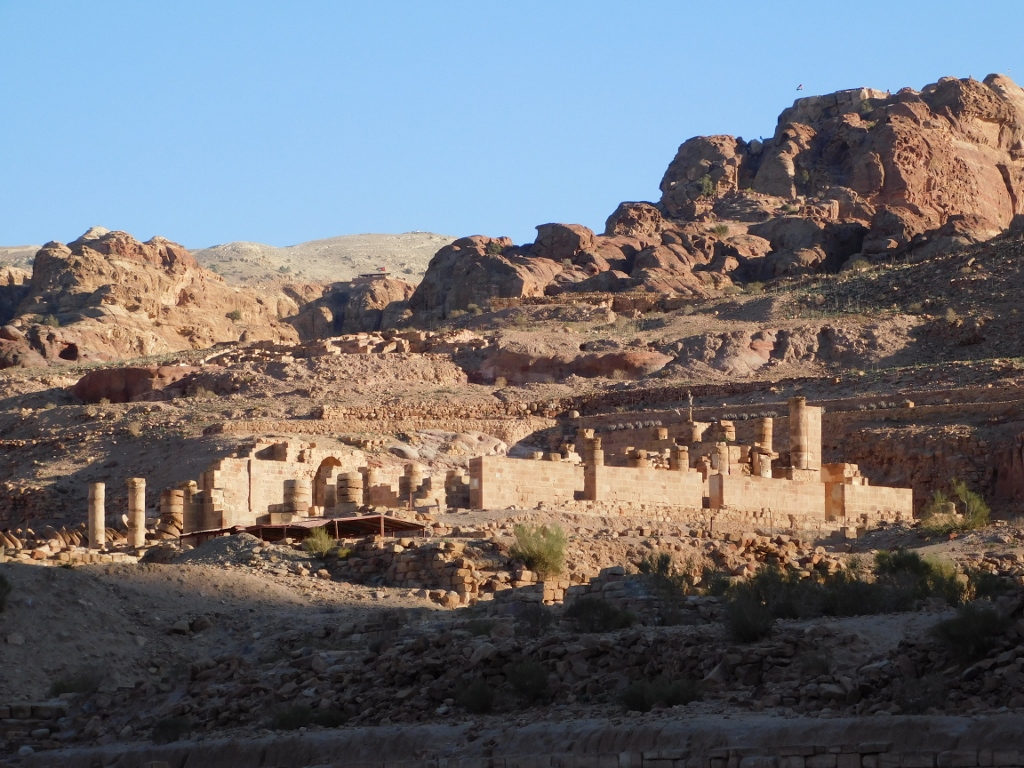 Petra, Great Temple, a detail
Petra, Great Temple, a detail
The Great Temple is the largest free-standing structure in Petra and it covers the area of around 7500 sq. m. It was built at the end of the 1st century BCE, but was later expanded and added to. It has a rectangular ground plan with a shorter side being parallel to the Colonnaded Street and it is precisely from this side that you enter the temple complex. Directly next to the street there used to be a Propylaeum that served as the formal entrance.
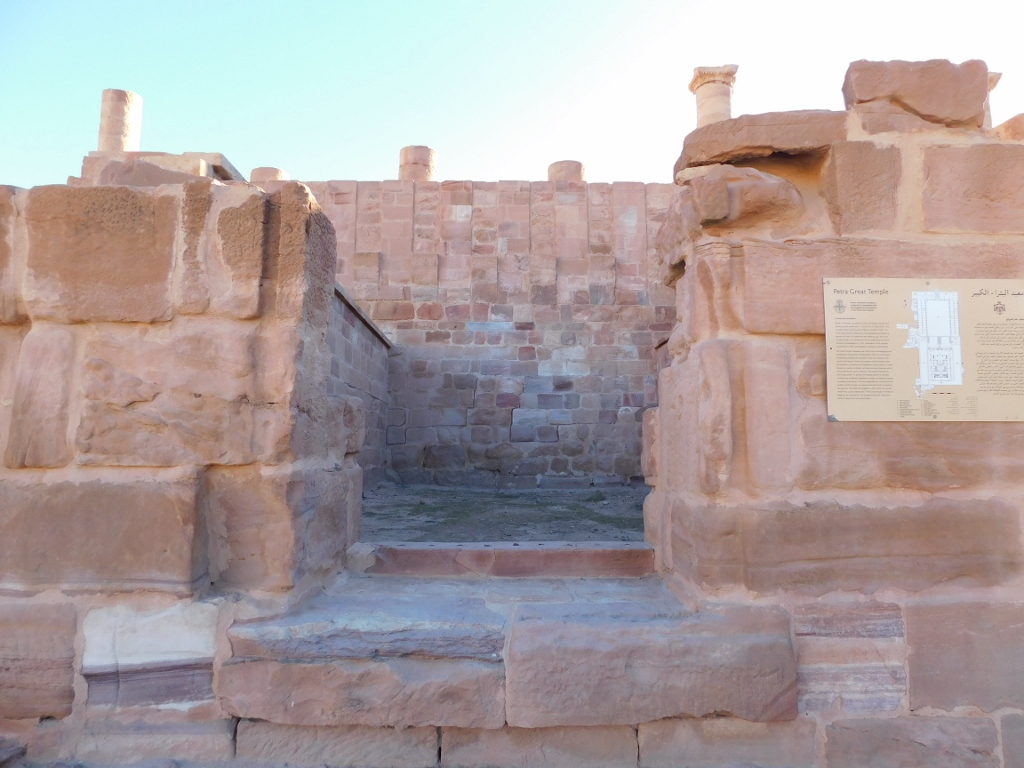 Petra, Great Temple, a part of the remains of the east Propylaeum
Petra, Great Temple, a part of the remains of the east Propylaeum
Between the east and the west Propylaeum, you climb a wide staircase up to the Lower Temenos and somewhat farther down, using another staircase, up to the Upper Temenos, since the Great Temple was built at different levels.
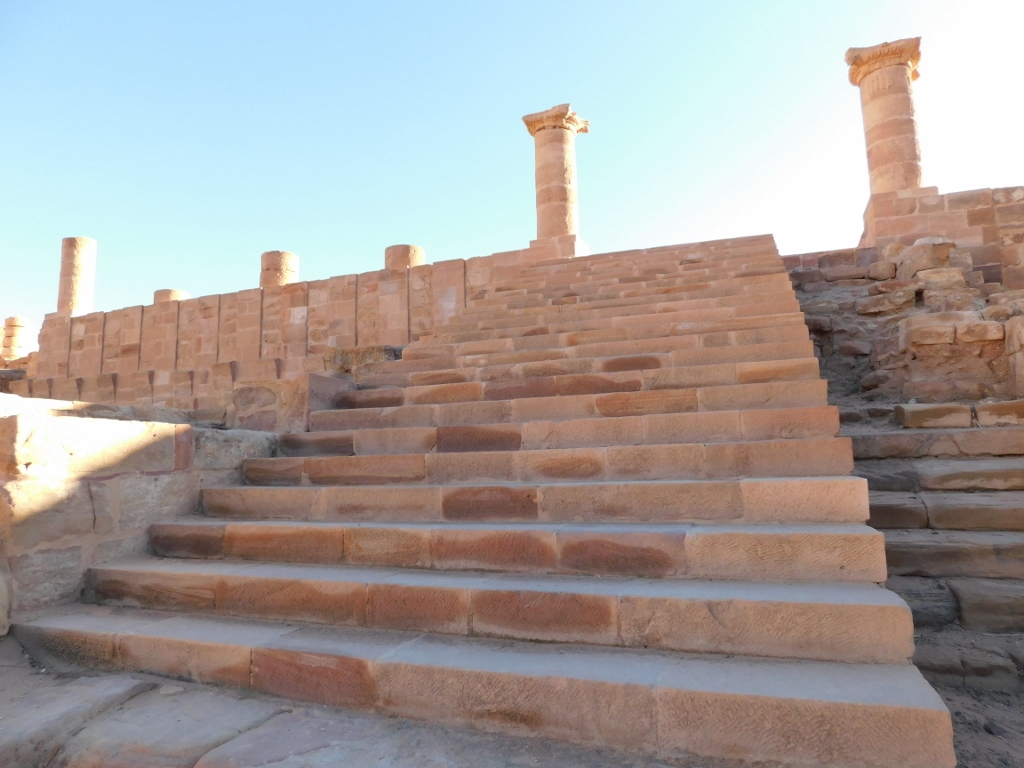 Petra, Great Temple, the staircase leading to the Lower Temenos
Petra, Great Temple, the staircase leading to the Lower Temenos
I got here by the stairs and walked a little around the Lower Temenos still admiring both the structure itself and its broader surroundings.
 Petra, Great Temple, Lower Temenos
Petra, Great Temple, Lower Temenos
The first thing that needs to be said here is that although this structure is still called the Great Temple, most of the researchers today agree that this was not a temple at all, but a structure used by the Nabataean kings for representation purposes. It is presumed that this was not a ruler palace though, since the size of the residential units would not be appropriate for such an important place. Also, there are no kitchens, stables and similar facilities that accompany ruler palaces.
As I’ve mentioned before, the Romans annexed the Nabataean Kingdom and Petra in 106 CE. Although they introduced certain architectural changes to the Great Temple and also repaired it after an earthquake from the beginning of the 2nd century, all evidence suggests that the structure stopped to be used at the end of the 2nd century. In 363 CE, Petra was hit by a powerful earthquake that seriously damaged the Great Temple. Over time smaller residential buildings were made here and then there were earthquakes again, the time went by, etc. Finally, in the 20th century, the Bedouins used the courtyard within the Lower Temenos for agriculture, while some of them also lived here.
The Great Temple was “discovered” only at the end of the 20th century and since 1993 there have been regular archaeological research and excavations conducted here.
Today, in the Lower Temenos it is possible to see remains of colonnades. On the east and the west sides of the courtyard there used to be three colonnades each that were covered by a roof. Little has survived to date (in addition to the impact of the time and natural catastrophes, a lot has been stolen or used for the construction of something else).
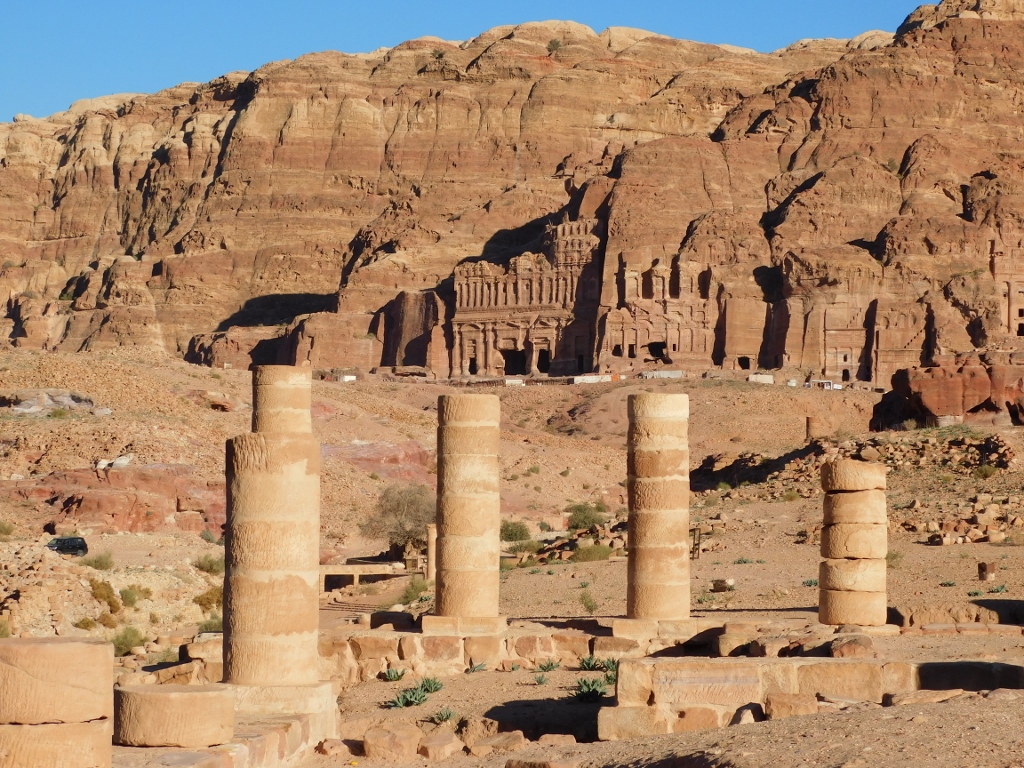 Petra, Great Temple, Lower Temenos, a detail
Petra, Great Temple, Lower Temenos, a detail
When I was here it was already past 4 pm and according to the official information, the site was about to be closed. Since I had already decided that this afternoon I would like to reach the “square” in front of the Qasr al-Bint temple before heading back, I realised I did not have the time to visit the rest of the Great Temple, i.e., to go up to the Upper Temenos. Moreover, I completely forgot about this the following day when I walked along the Colonnaded Street again. Does this mean that I should revisit Petra? I would not mind that at all.
Still, let me just mention that the Upper Temenos contains a large columned building, the so-called “temple” and this is the part of the Great Temple that can be seen in the first photo in this sequel. It is interesting that after the annexation the Romans built a small theatre within this segment of the overall structure. It is almost certain that this small theatre was used not only for plays, but also for the meetings of the city’s council.
So, I did not see this, but before leaving the Lower Temenos, descending down to the street, I noticed yet another detail – the capitals on the columns beside the staircase. Namely, ALL the columns within the Lower Temenos used to have capitals that had heads of Asian elephants made of stone on the four corners. Those that have survived intact are rare and they can be seen at a museum, but here in situ, the visitor can see only some truncated remains. It did not matter; I still found them very interesting.
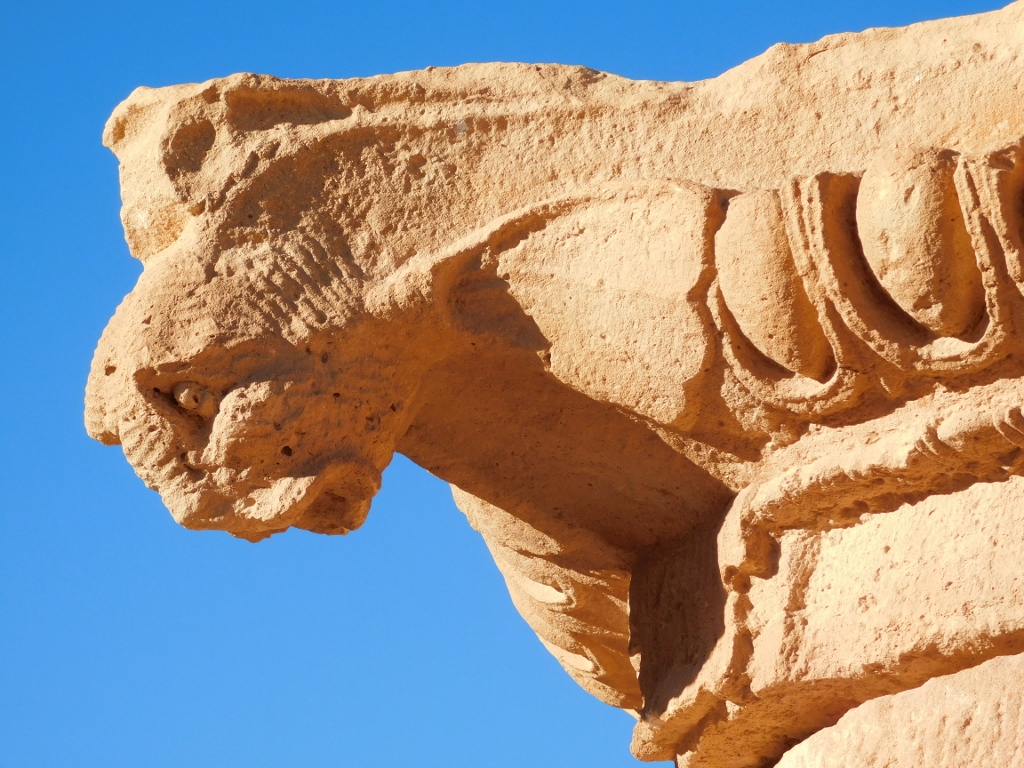 Petra, Great Temple, Lower Temenos, a detail: this elephant has lost its trunk
Petra, Great Temple, Lower Temenos, a detail: this elephant has lost its trunk
It is also important to say that next to the Great Temple it is possible to see remains of a Roman-Byzantine bath complex, as well as remains of the royal garden and a water pool. It is presumed that this was made not only for the kings to enjoy it, but also for the guests to be impressed by an almost paradise-like garden in the middle of the rocky desert landscape.
I did not visit these demolished remains either, but rather from the top of the staircase of the Great Temple I first looked at the opposite side of the Colonnaded Street where on the elevation I could see remains of the Winged Lion Temple.
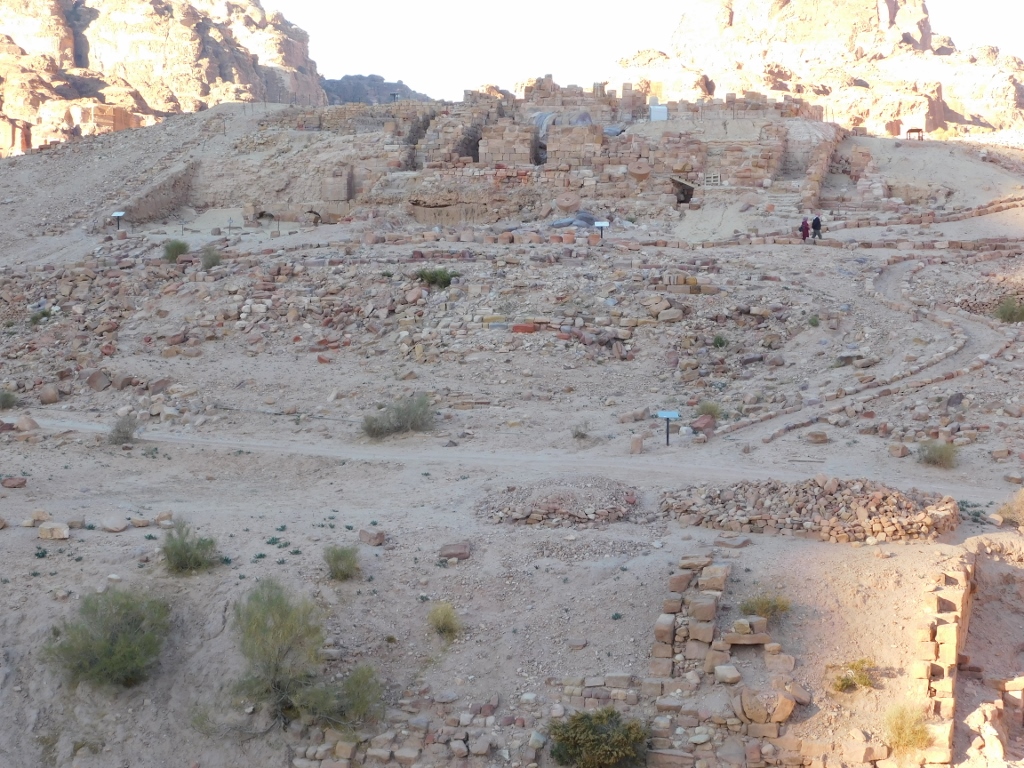 Petra, remains of the Winged Lion Temple
Petra, remains of the Winged Lion Temple
This temple, or more accurately a temple complex, was positioned in a very prominent place, right across the Great Temple or the most representative complex of the Nabataean rulers.
During the excavations, the archaeologists discovered parts of capitals with winged lions, hence the name of the temple. They have also ascertained that the temple was built at the beginning of the 1st century CE and that its use was stopped by that devastating earthquake from 363. On the basis of the discovered objects, it has been concluded that the temple was dedicated to the supreme Nabataean goddess al-Uzza.
Although there is an information board in the Colonnaded Street that shows what the temple, according to the researchers, used to look like originally, bearing in mind the state of the ruins as seen in the photo above, as well as my physical state, I did not climb here either in order to see the remains of the Winged Lion Temple.
Instead, I focused my attention to the part of the Petra where there is Qasr al-Bint.
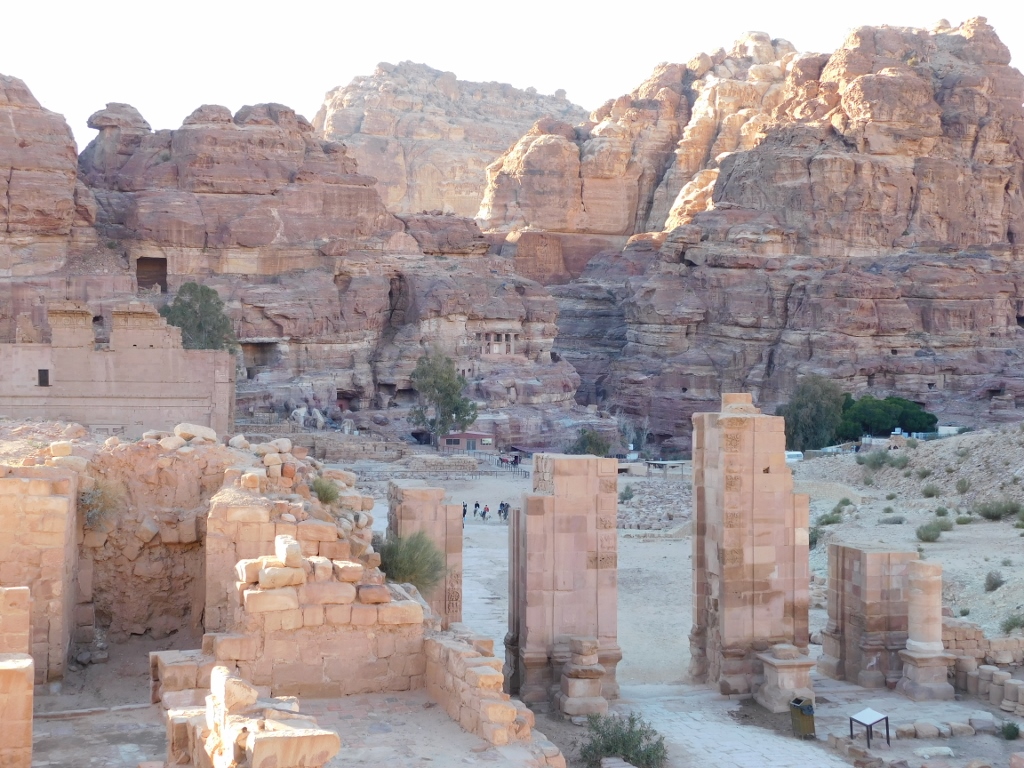 Petra, central part with the Qasr al-Bint temple (to the left behind the wall made of stone blocks)
Petra, central part with the Qasr al-Bint temple (to the left behind the wall made of stone blocks)
In order to get to the part of Petra with the Qasr al-Bint temple, you first need to continue along the Colonnaded Street and then go through the Temenos Gate or rather its remains. This gate was used in order to enter the holy part of the city. Let me clarify. The term “temenos” was used in Mediterranean cultures to signify a part of the land specifically set apart and designated to be used solely by the ruler or possibly for the purpose of communicating with gods. In the case of the Great Temple, this term is used to mark two important segments of the structure (the upper and the lower ones) used by the Nabataean kings presumably for representation purposes. Here, however, we are talking about Temenos, the holy part of the city with temples, in other words, it signifies the use of the space for religious purposes.
The remains of the gate used in order to enter Temenos, the holy part of the city, can also be seen in the previous photo, but here they are again, seen from the staircase of the Great Temple by the Propylaeum. By the way, the gate was built after the annexation by the Roman Empire and it is 17 m wide.
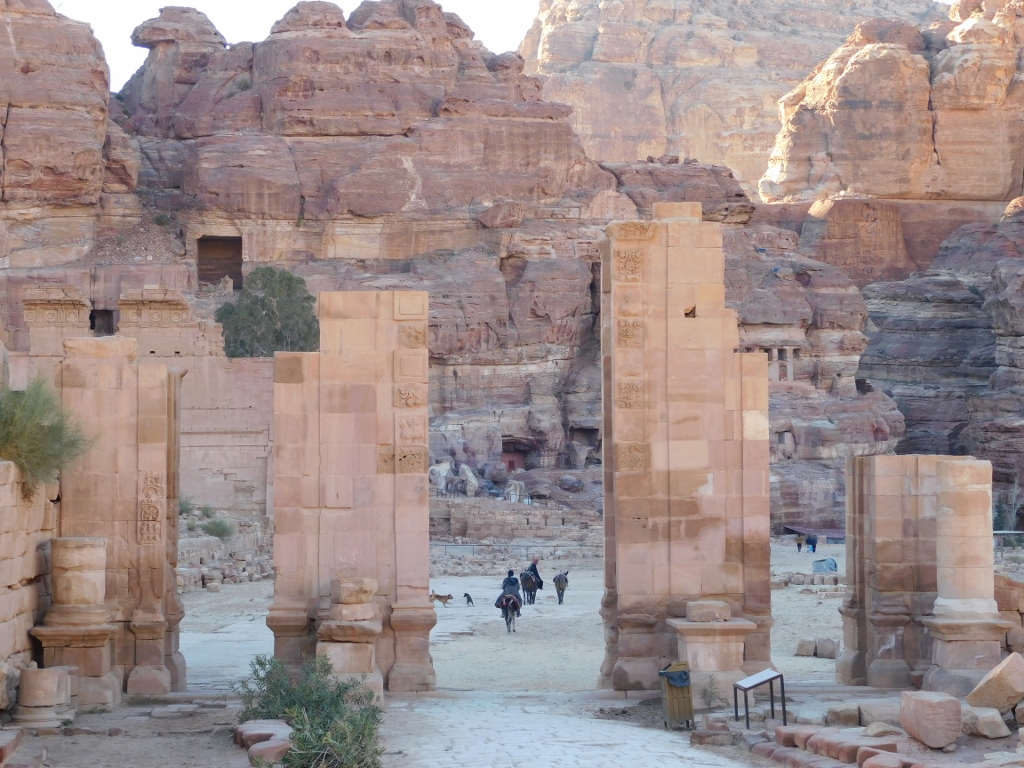 Petra, Temenos Gate
Petra, Temenos Gate
Some hundred metres from the gate, on the left-hand side, there are remains of the Qasr al-Bint temple.
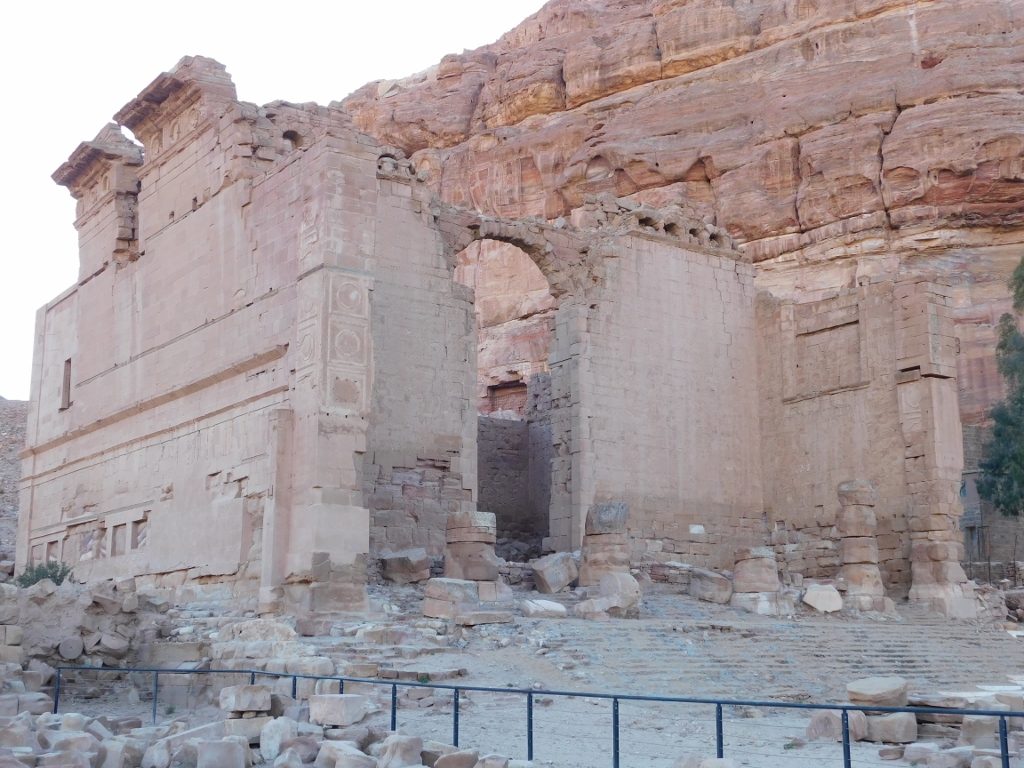 Petra, Qasr al-Bint temple
Petra, Qasr al-Bint temple
Here was the ultimate point of my sightseeing of Petra this afternoon, not in terms that this was something I most wanted to see, but rather I wanted to get to this point before heading back. Taking into consideration that I was planning to come back on the following day as well, which I did, I will write about the temple later.
As it may be seen in the photos, at this time of the day there were only some Bedouins around here who probably worked with tourists during the day, so were now killing time. I must admit I actually don’t know what they were doing there. However, as it turned out, apart from them and me, there were also two other visitors who like me started to walk slowly towards the exit. In other words, I can almost say that I had entire Petra all to myself. I guess that helped me ignore the tiredness I felt, but I still had to endure.
Because, I had to cover almost 3 km to get out of the Siq, then around 1 km to the Visitor Centre and another almost 1.5 km to my hotel. So, a total over 5 km, with the altitude difference of around 370 m, which in my state was not negligible at all.
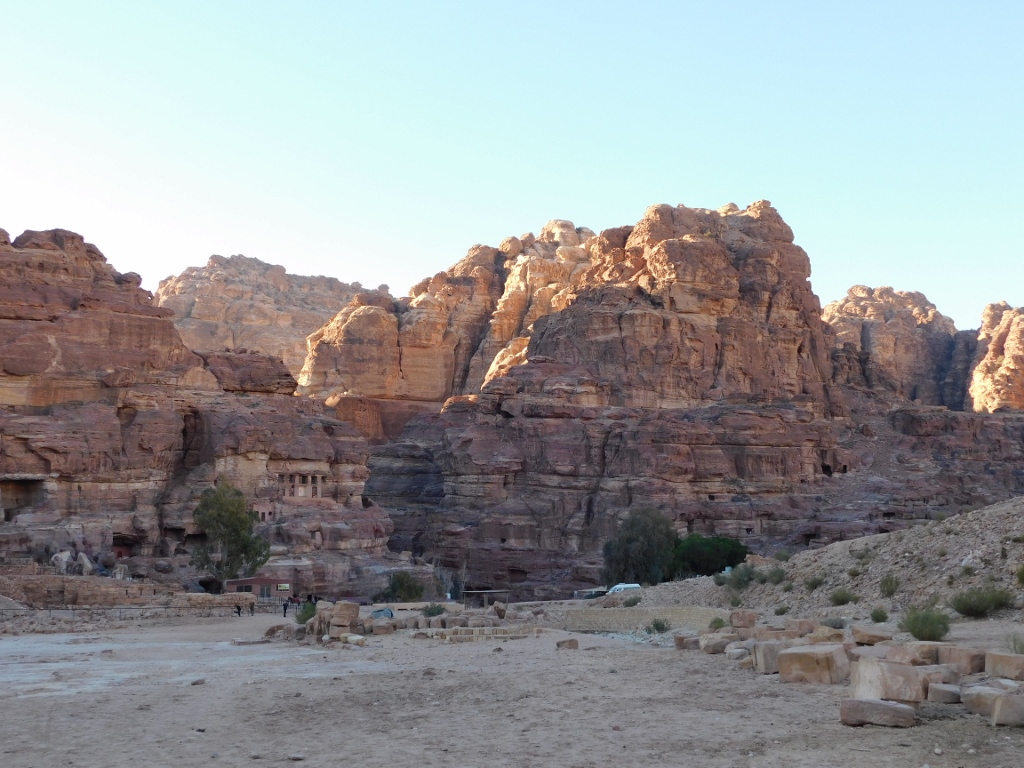 Petra, the almost completely deserted square, Temenos Courtyard, beside the Qasr al-Bint temple
Petra, the almost completely deserted square, Temenos Courtyard, beside the Qasr al-Bint temple
As opposed to this part that was in the shade, on the other side some other parts of Petra continued to be perfectly lit by the setting Sun and I absolutely enjoyed the sights I was surrounded with.
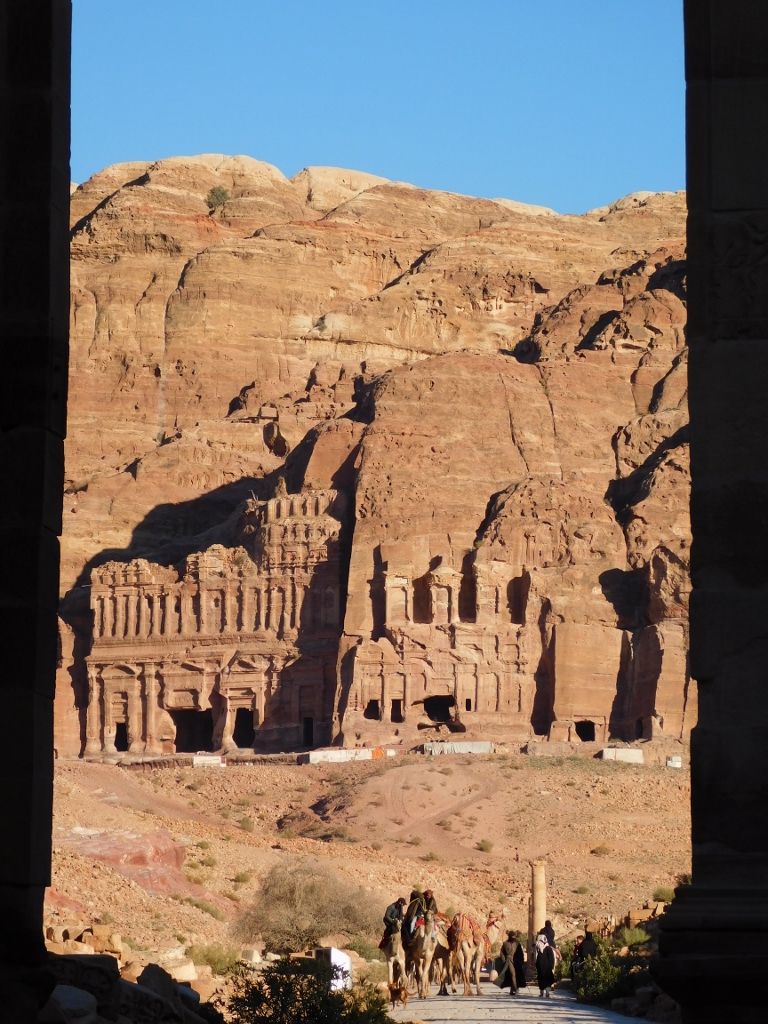 Petra, Palace Tomb and the Corinthian Tomb seen between the columns of the Temenos Gate
Petra, Palace Tomb and the Corinthian Tomb seen between the columns of the Temenos Gate
 Petra, the Jabal al-Khubtha massif and the Royal Tombs
Petra, the Jabal al-Khubtha massif and the Royal Tombs
In addition to the monuments of culture, there were also some almost ordinary and yet absolutely fantastic sights.
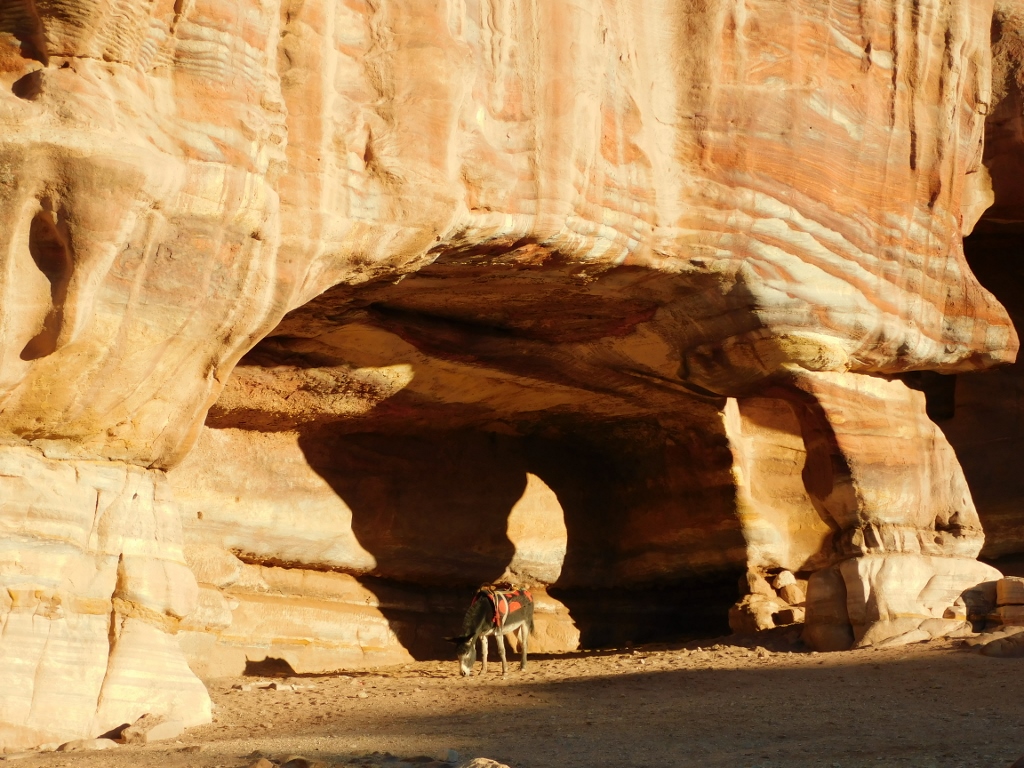 Petra, details lit by the setting sun
Petra, details lit by the setting sun
Still, the day was getting close to its end and there was less and less of the direct sunlight, but even under such circumstances I could see nicely and take photos of the parts of Petra that I had walked by earlier and that I have written about in my previous sequels of these travel stories.
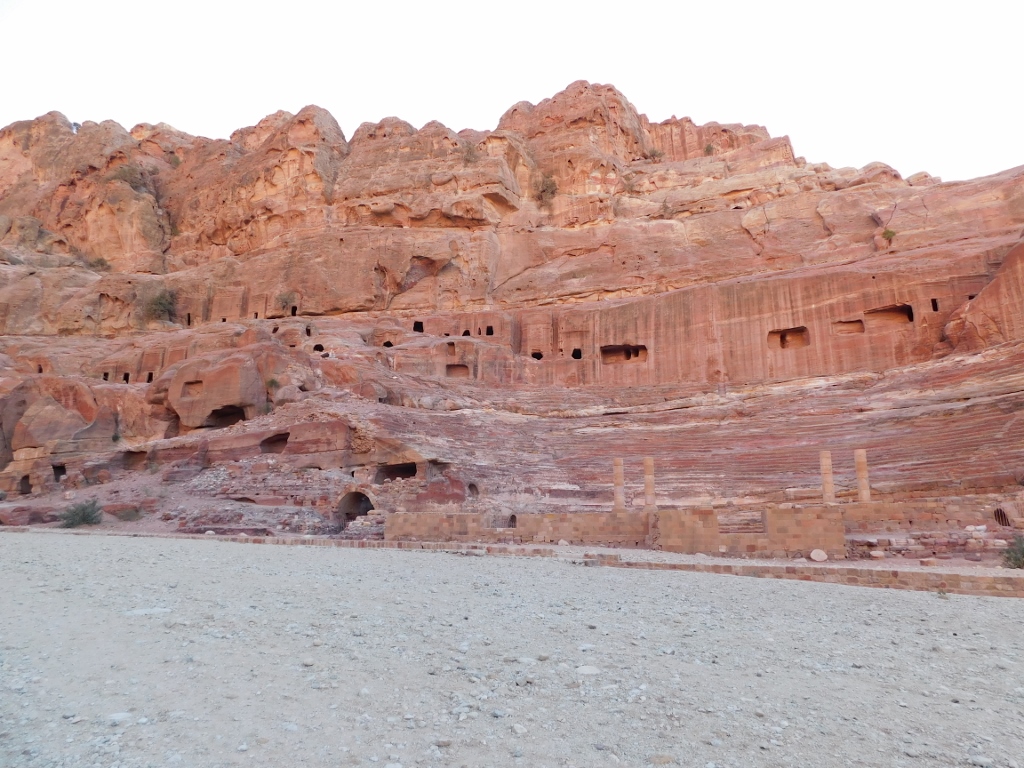 Petra, Theatre (right) and a part of the Theatre Necropolis (left)
Petra, Theatre (right) and a part of the Theatre Necropolis (left)
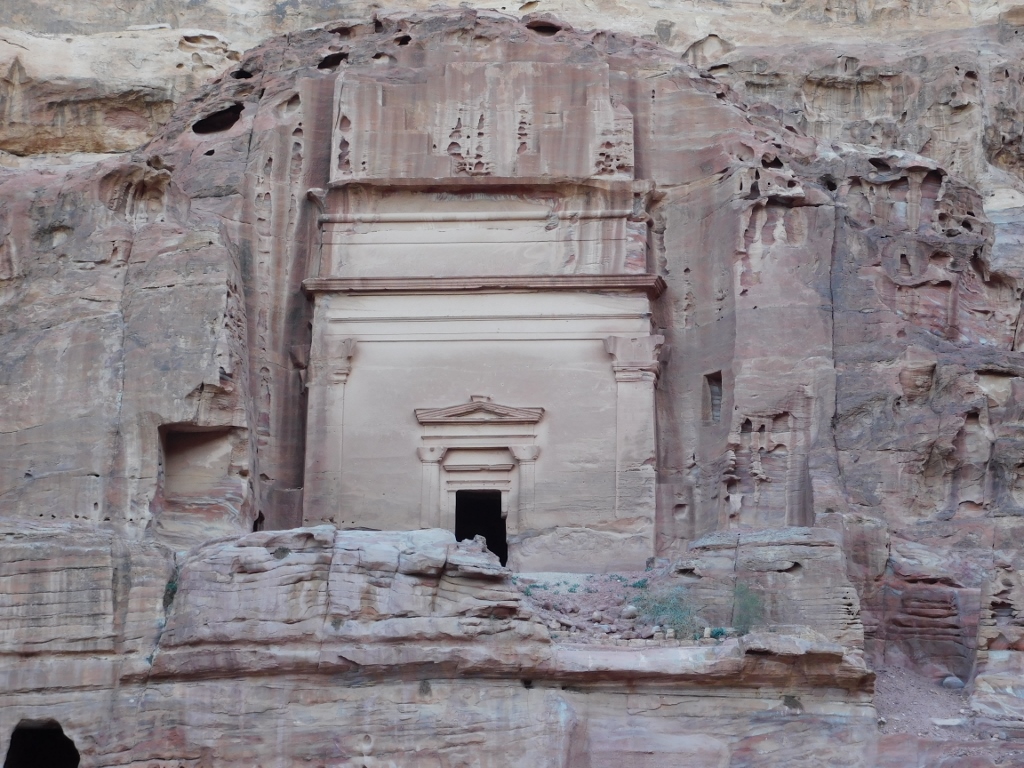 Petra, Tomb of Uneishu
Petra, Tomb of Uneishu
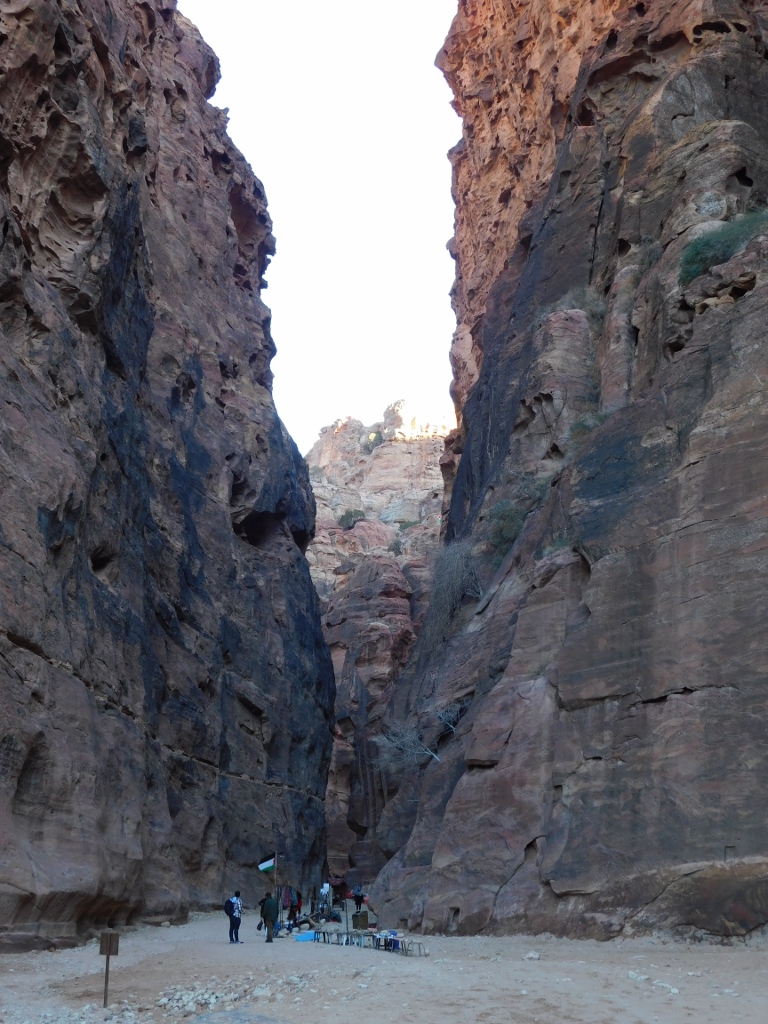 Petra, entrance into the Outer Siq
Petra, entrance into the Outer Siq
And then I also came to Wadi al-Jarra with the al-Khazneh or the Treasury.
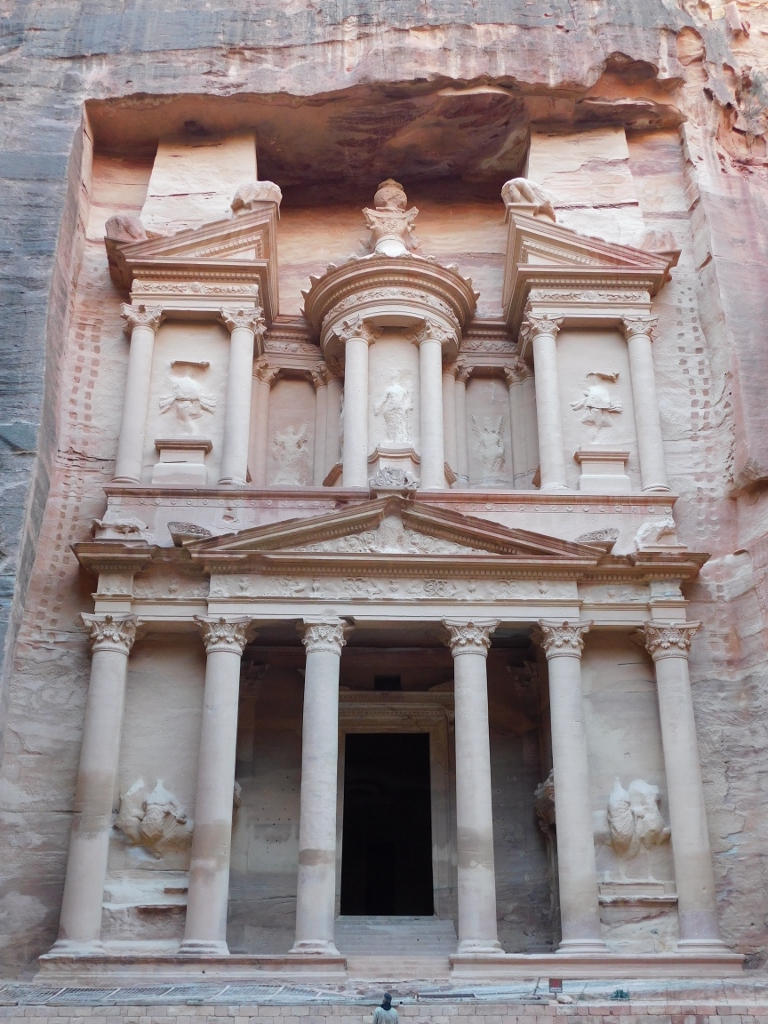 Petra, al-Khazneh
Petra, al-Khazneh
Perhaps somebody in my shoes could resist and simply pass by and enter the Siq. But, not me. I had to look again at the details and then also take photos of some parts of the Treasury. However, I have already written about this, so here come only photographs.
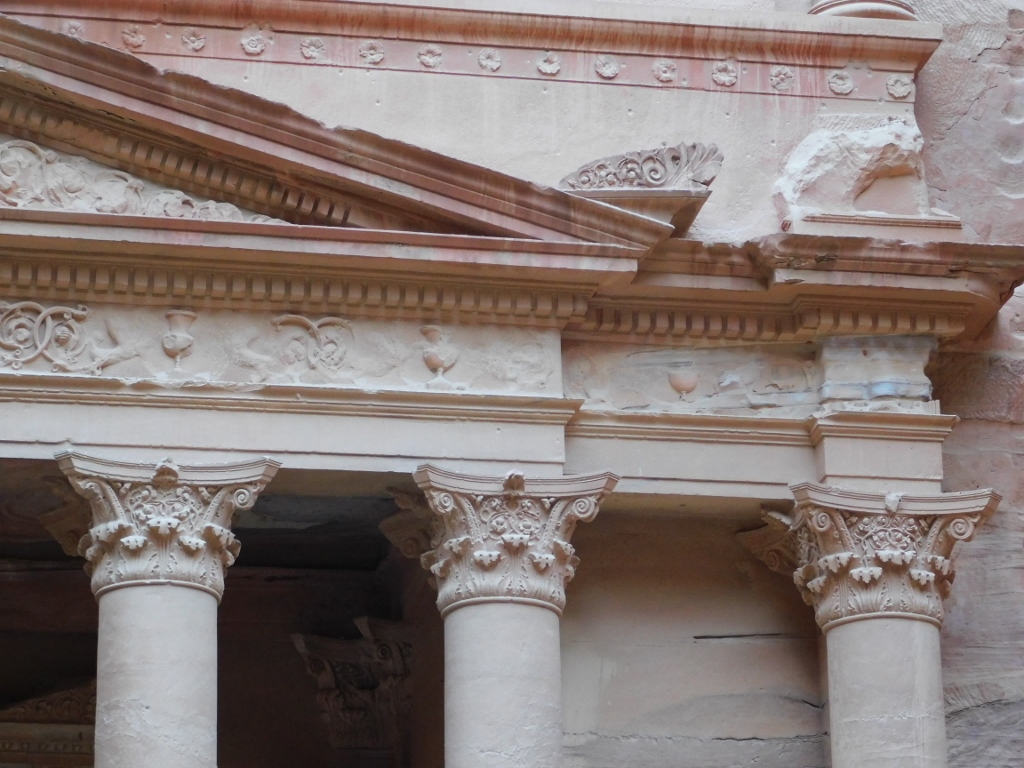 Petra, al-Khazneh, details if the lower segment of the facade
Petra, al-Khazneh, details if the lower segment of the facade
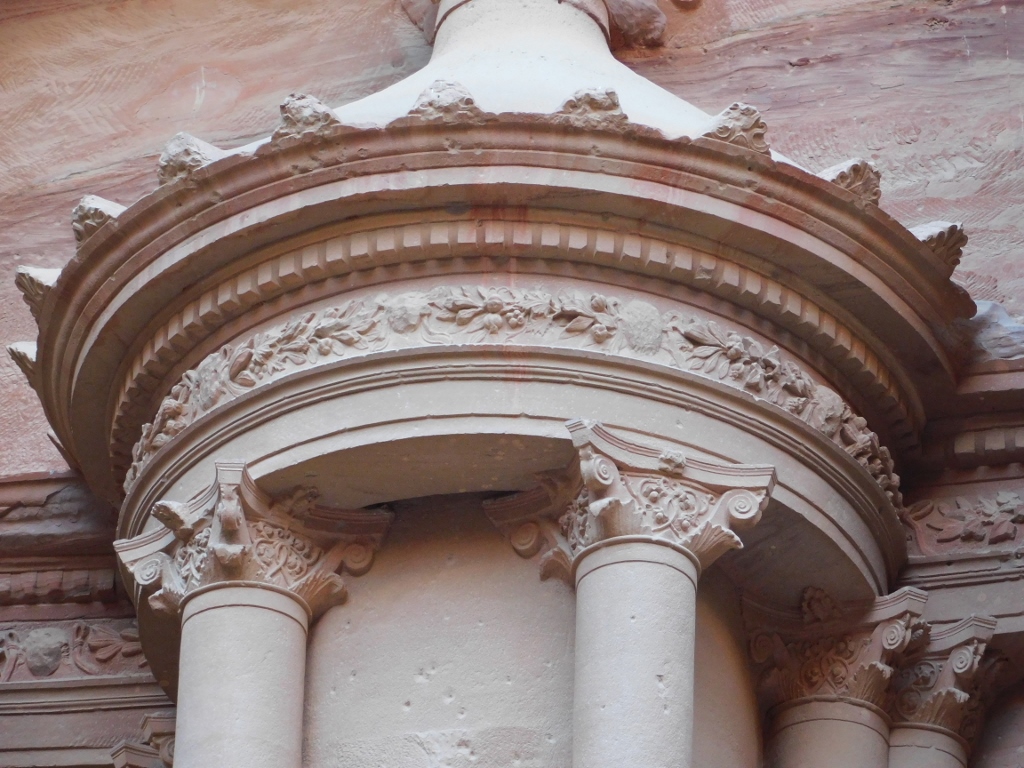 Petra, al-Khazneh, top of the tholos
Petra, al-Khazneh, top of the tholos
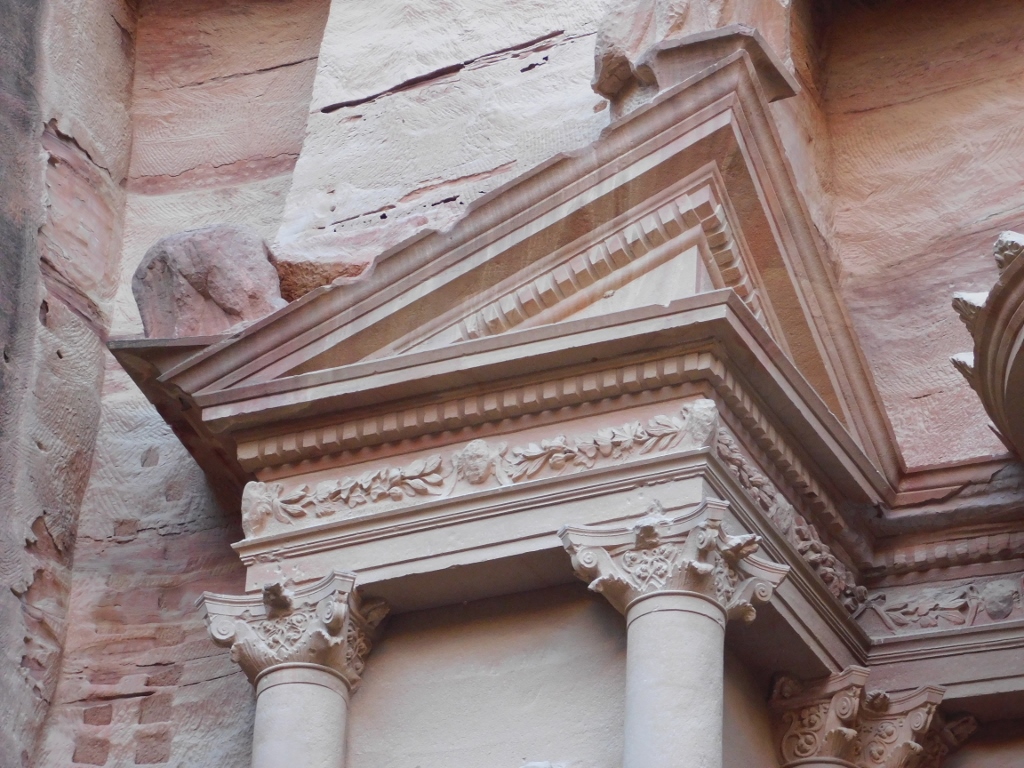 Petra, al-Khazneh, details of the left broken pediment
Petra, al-Khazneh, details of the left broken pediment
Still, after a while I did enter the Siq and from there I looked back again. By this time, there was nobody in front of the Treasury.
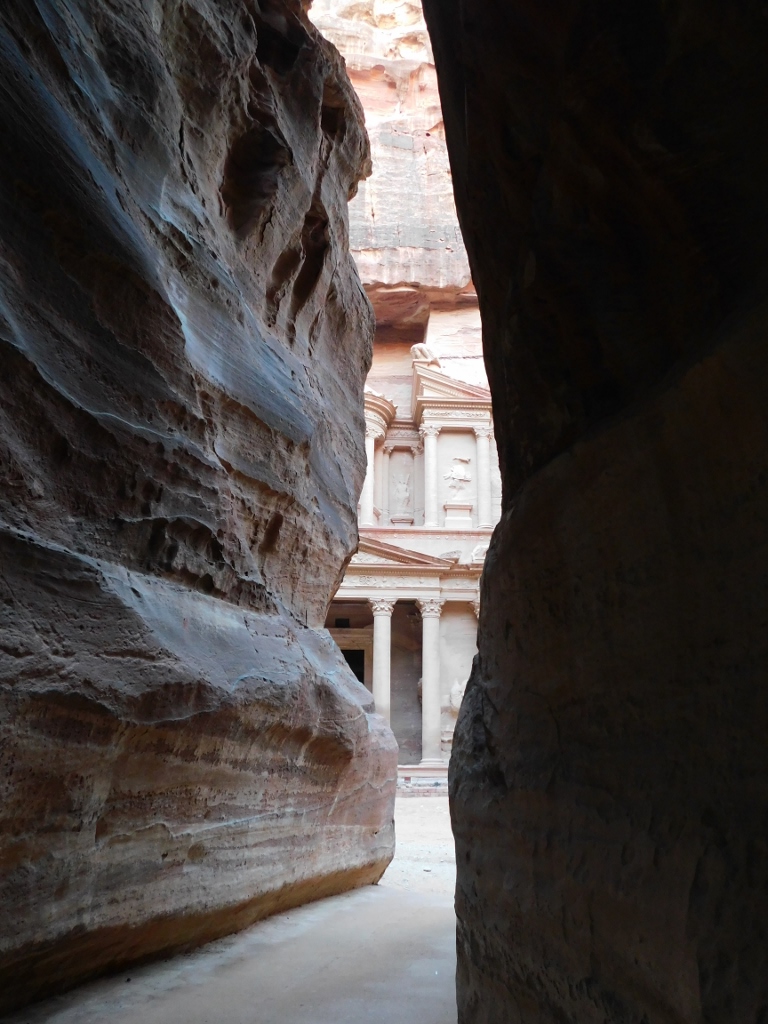 Petra, leaving al-Khazneh behind
Petra, leaving al-Khazneh behind
The walk along the Siq continued to be as impressive as ever, but now I could only hear some birds and my footsteps.
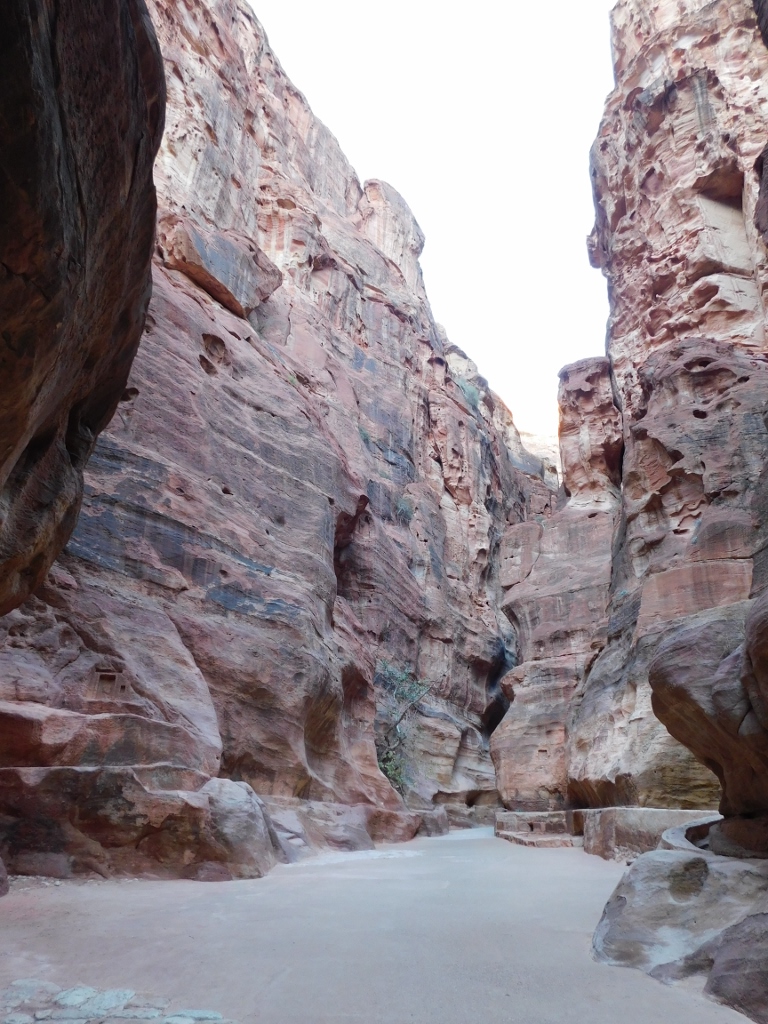 Petra, the Siq
Petra, the Siq
Admittedly, every now and then I could see those two women in front of me. On this day, the three of us were the last visitors here.
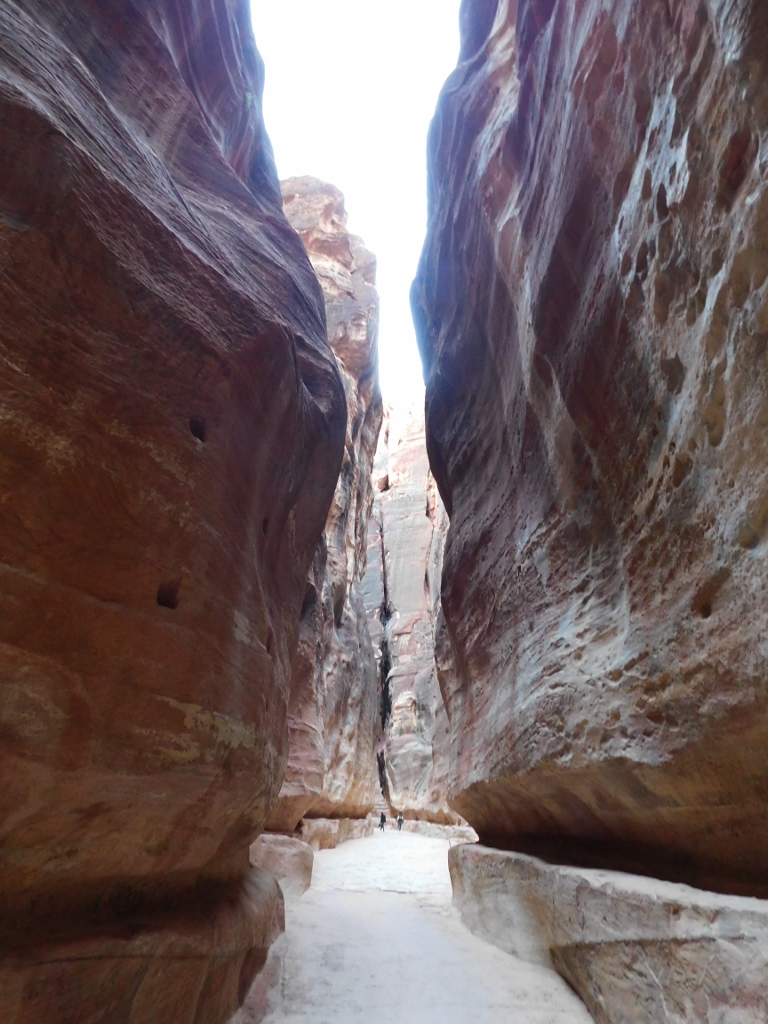 Petra, the Siq
Petra, the Siq
Again I walked past the Camel Caravan and the cut in the cliff beside which a part of this composition was carved so long ago.
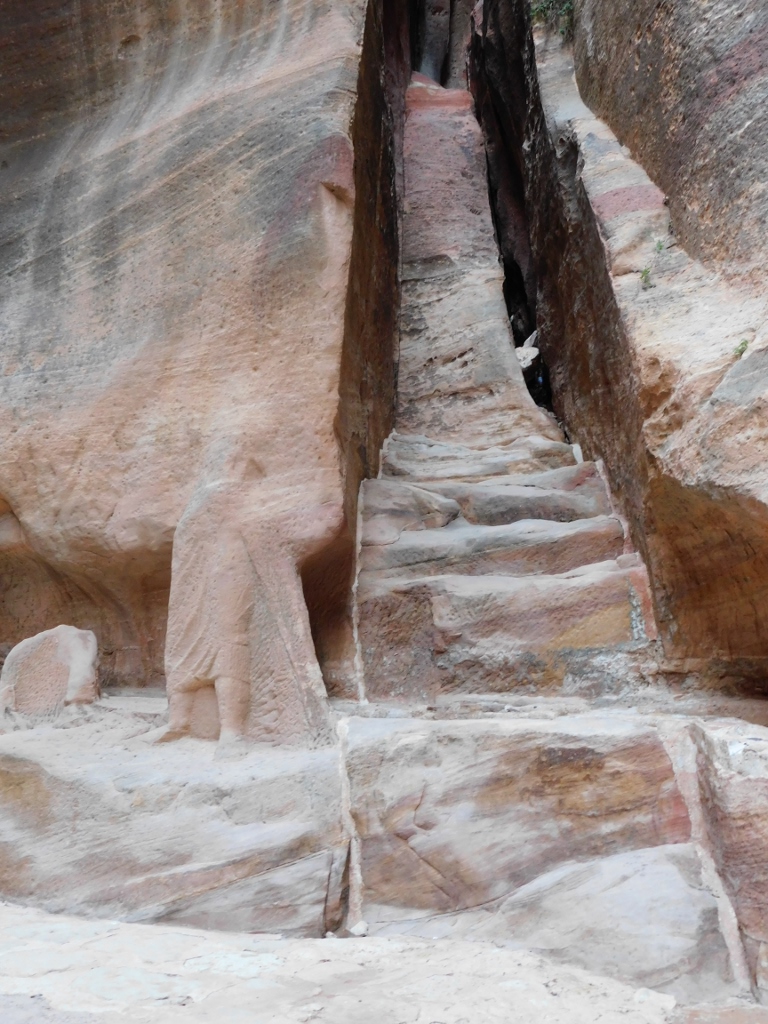 Petra, the Siq, cut in the cliff beside the Camel Caravan
Petra, the Siq, cut in the cliff beside the Camel Caravan
And then, of course, I left the Siq and headed for the exit from the site, looking back once again.
 Petra, entrance into the Siq is beside the structures seen on the right-hand side
Petra, entrance into the Siq is beside the structures seen on the right-hand side
I barely managed to drag myself back to the hotel, near which I bought a chicken shawarma and went straight to my room. I went to bed very early and soon I was asleep. The next day there was much more sightseeing for me and I really needed to rest as much as possible.
On the wings of the first day’s visit to Petra, I woke up fine, had breakfast and went down to the entrance to the site. I already had the two-day ticket, so after the quick check of the ticket, I headed straight for the Siq. By now, I knew exactly where I should go and what I could expect, but still I found it ALL most interesting because it was lit in a different manner.
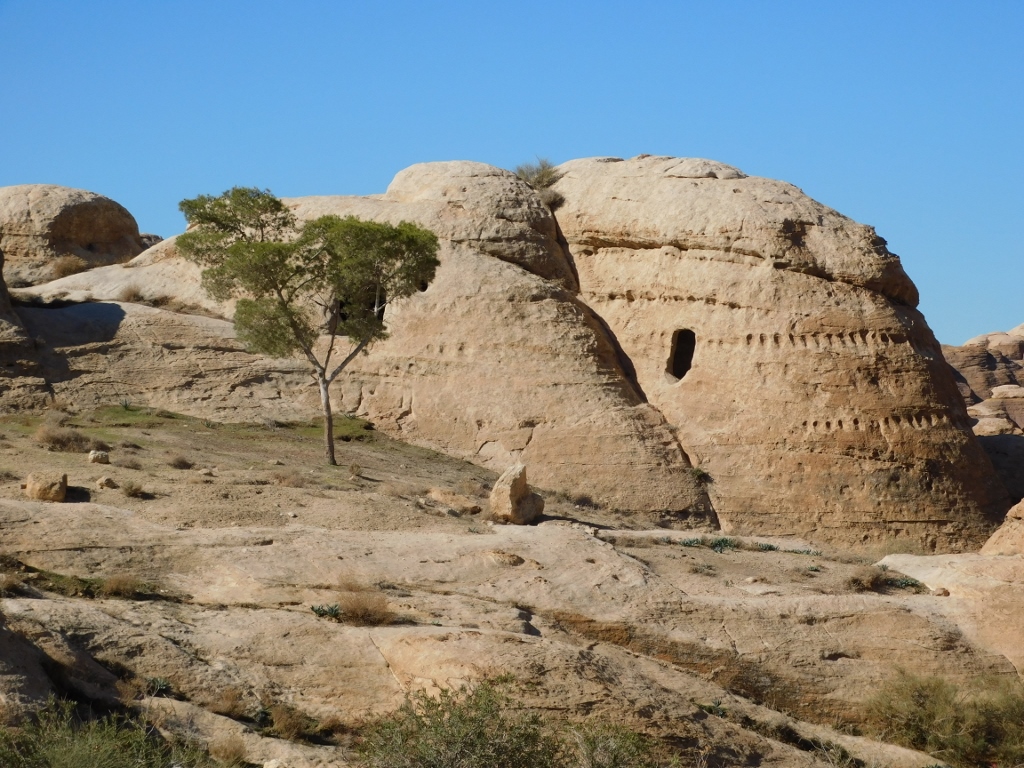 Petra, area of the Bab as-Siq, a detail
Petra, area of the Bab as-Siq, a detail
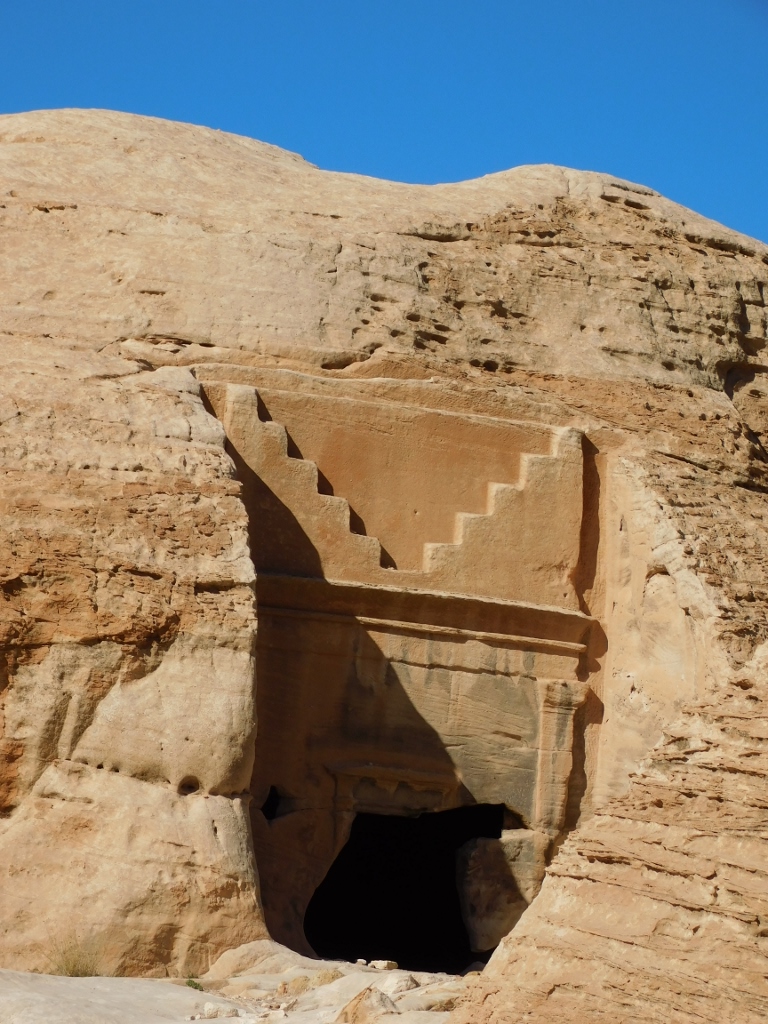 Petra, area of the Bab as-Siq, a detail
Petra, area of the Bab as-Siq, a detail
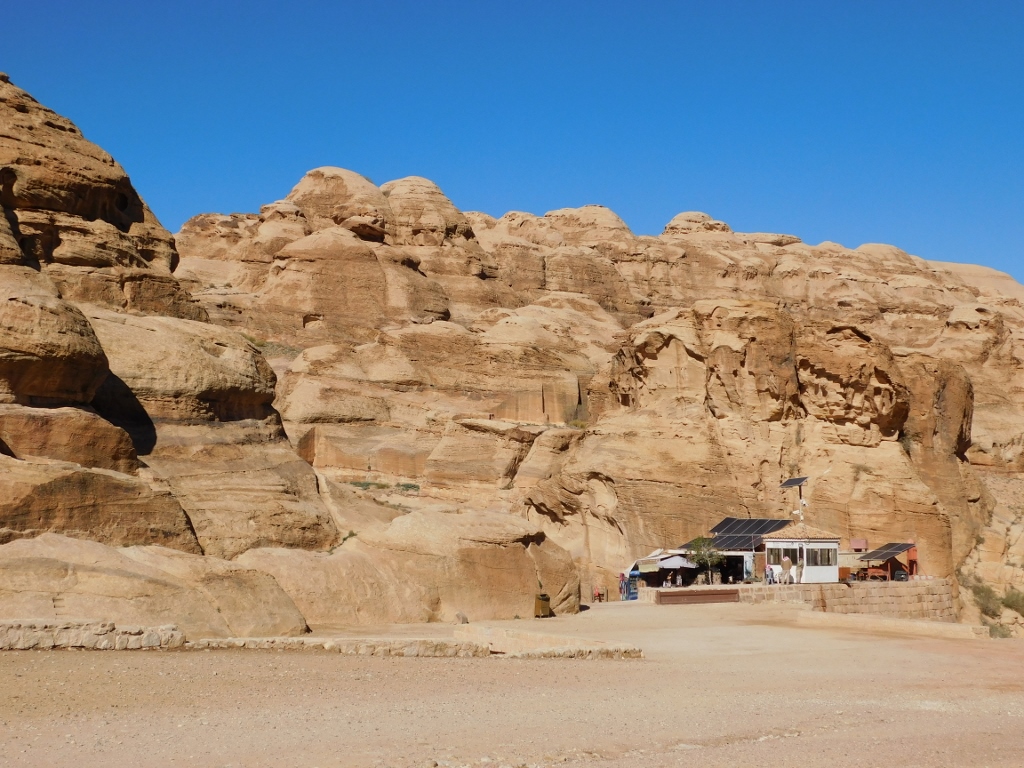 Who would say that the entrance into the Siq is among these boulders?
Who would say that the entrance into the Siq is among these boulders?
Needless to say, the Siq was still fascinating. Although I was certainly not among the first to start with the visit of Petra this morning, I did not see any visitor while walking through the Siq. I only encountered local residents.
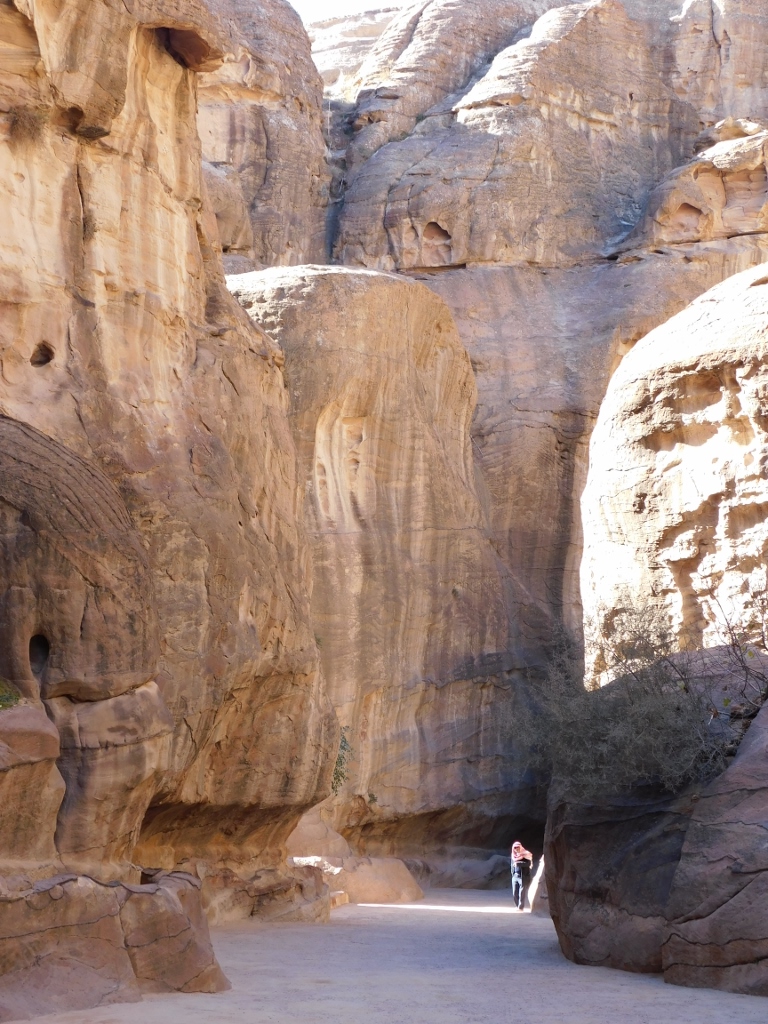 Petra, the Siq, a detail
Petra, the Siq, a detail
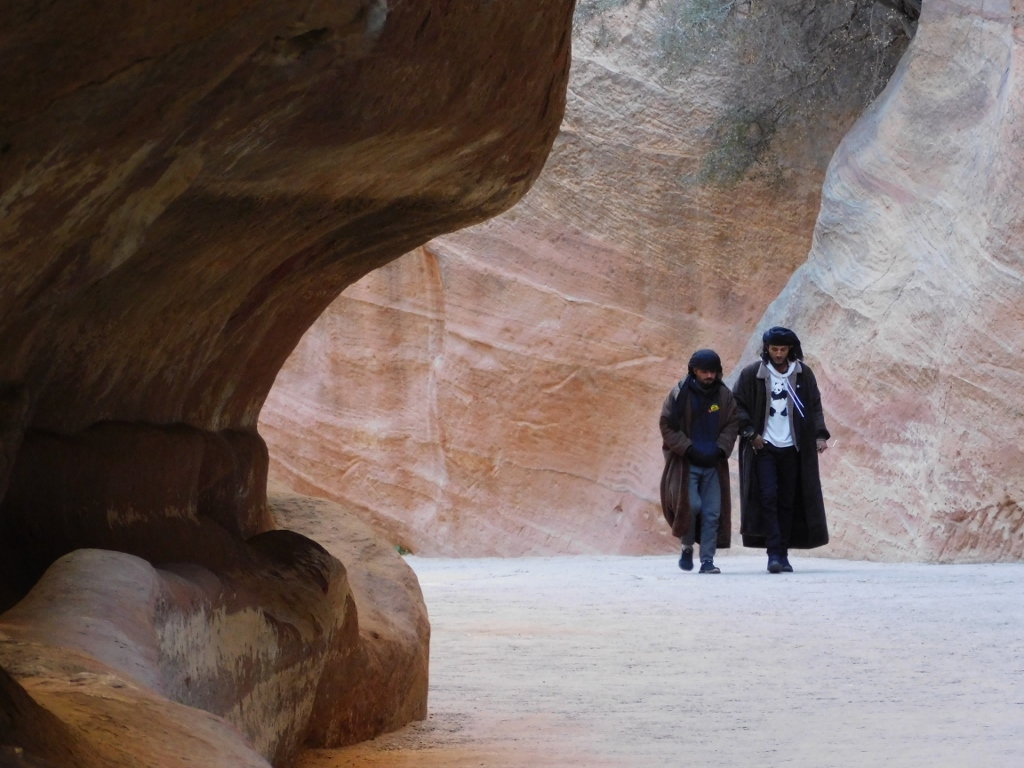 Petra, the Siq, a detail
Petra, the Siq, a detail
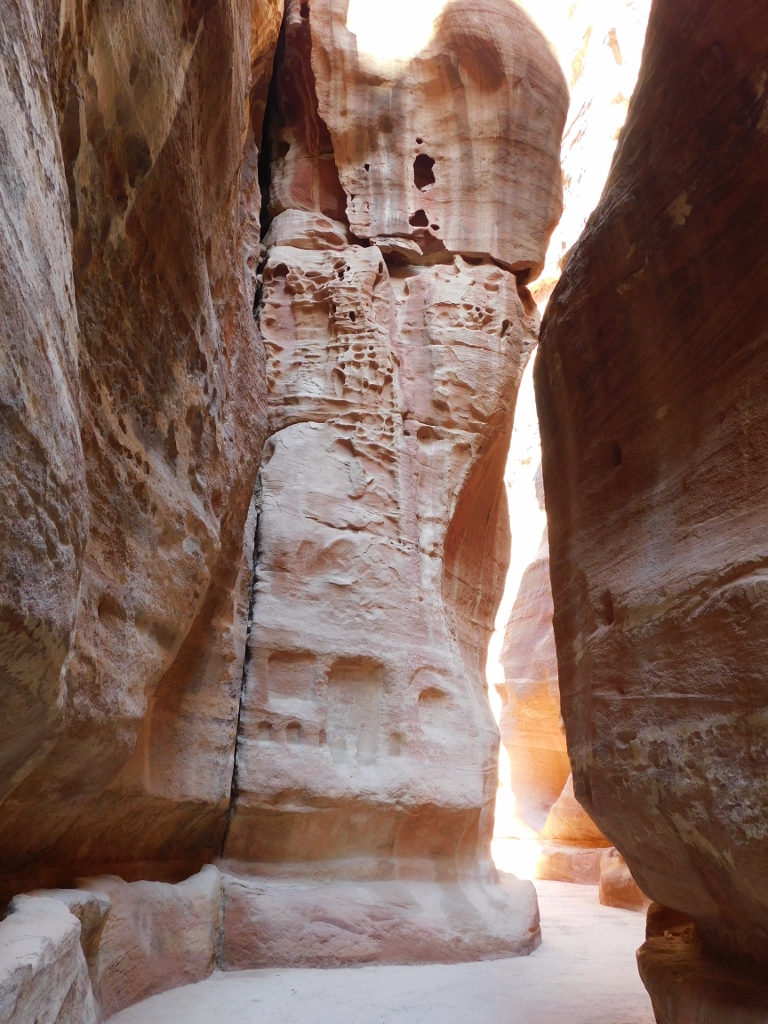 Petra, the Siq, a detail with votive niches “smoothed out” over time by erosion
Petra, the Siq, a detail with votive niches “smoothed out” over time by erosion
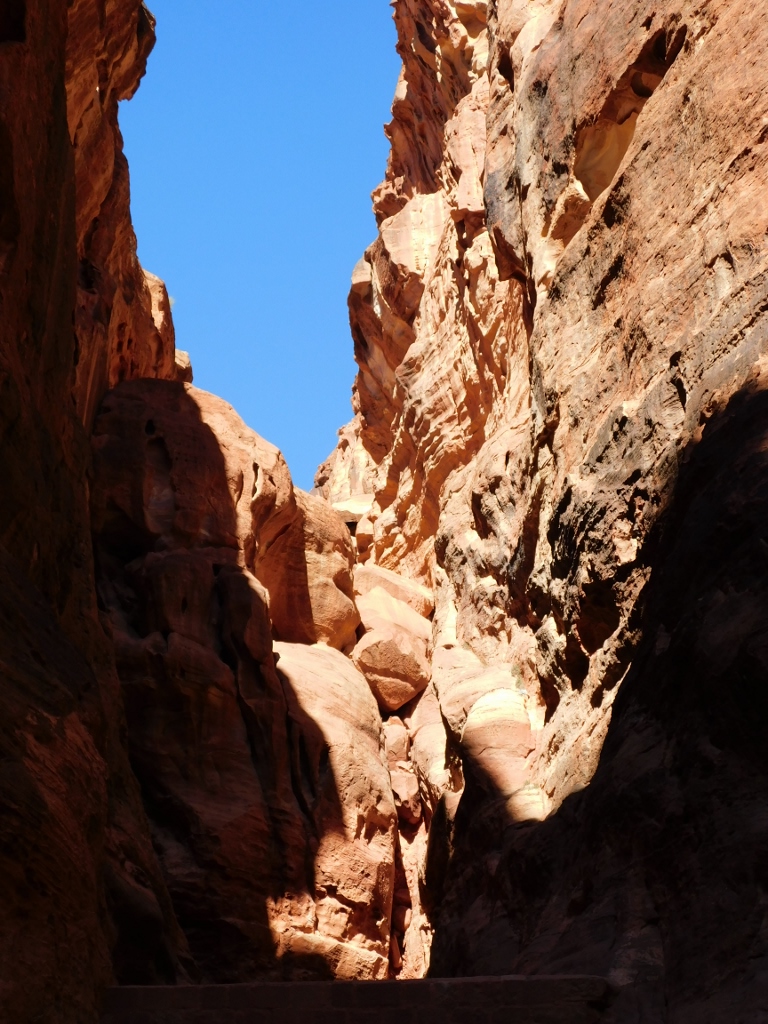 Petra, the Siq, a detail: red cliffs and blue sky
Petra, the Siq, a detail: red cliffs and blue sky
Having reached the end of the Siq, I was again left breathless by the dramatic image that the visitor faces here. This morning, al-Khazneh was again lit differently than the day before and I simply enjoyed immensely and was utterly happy that I finally came to visit Petra.
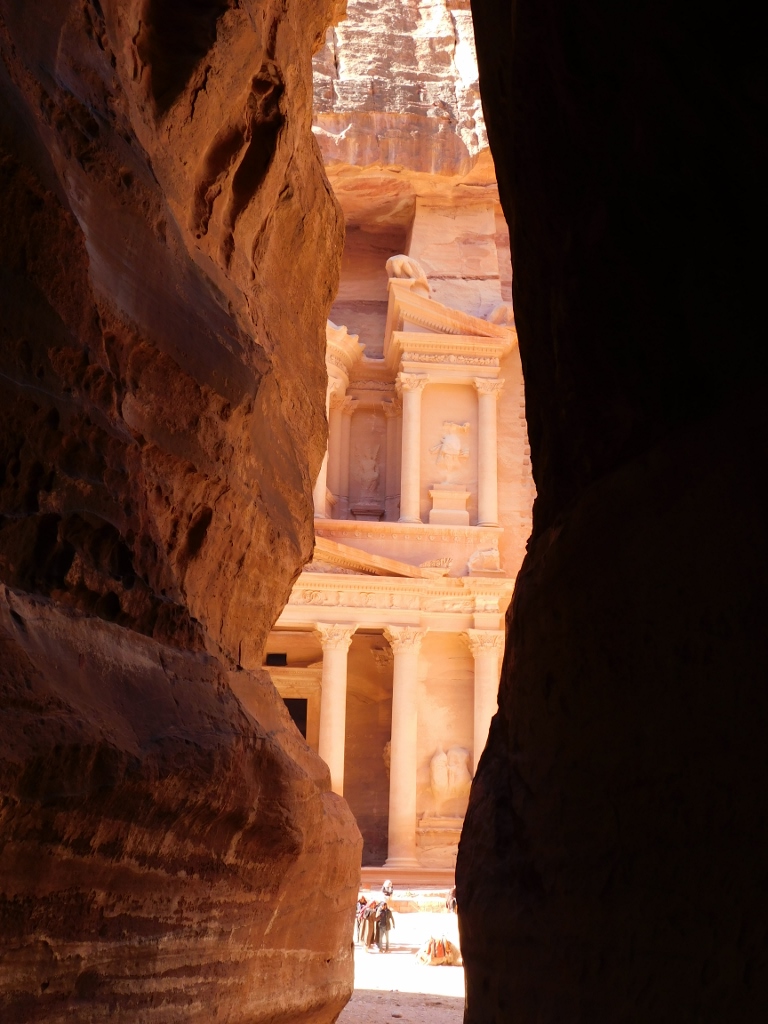 Petra, al-Khazneh
Petra, al-Khazneh
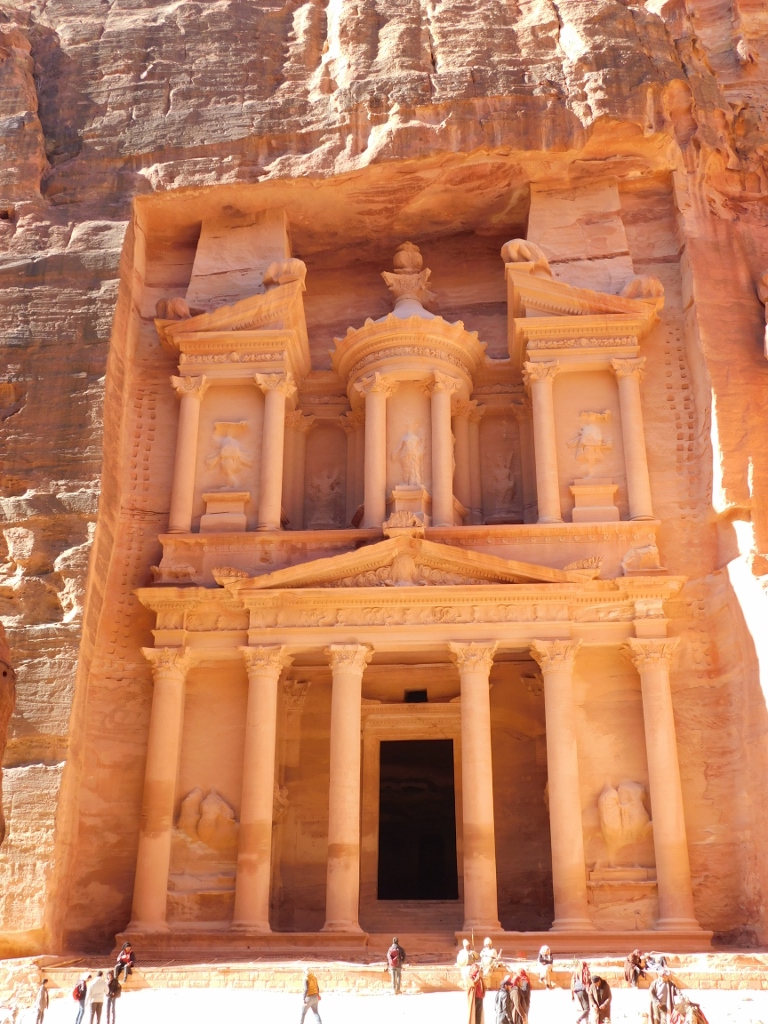 Petra, al-Khazneh
Petra, al-Khazneh
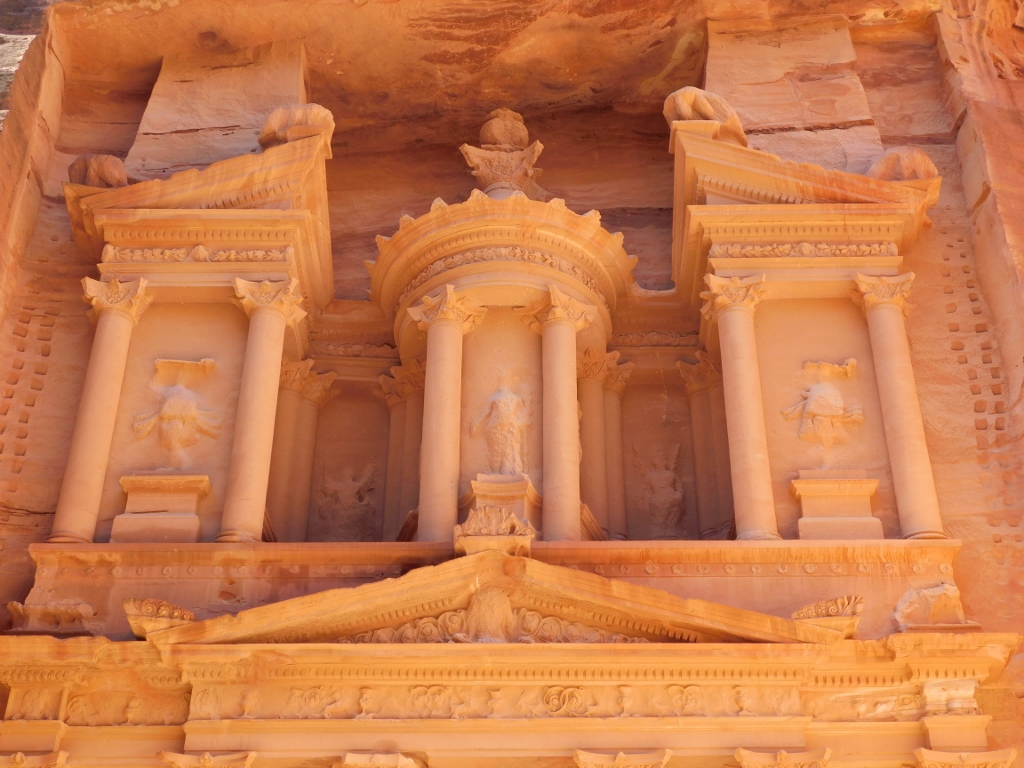 Petra, al-Khazneh, a detail
Petra, al-Khazneh, a detail
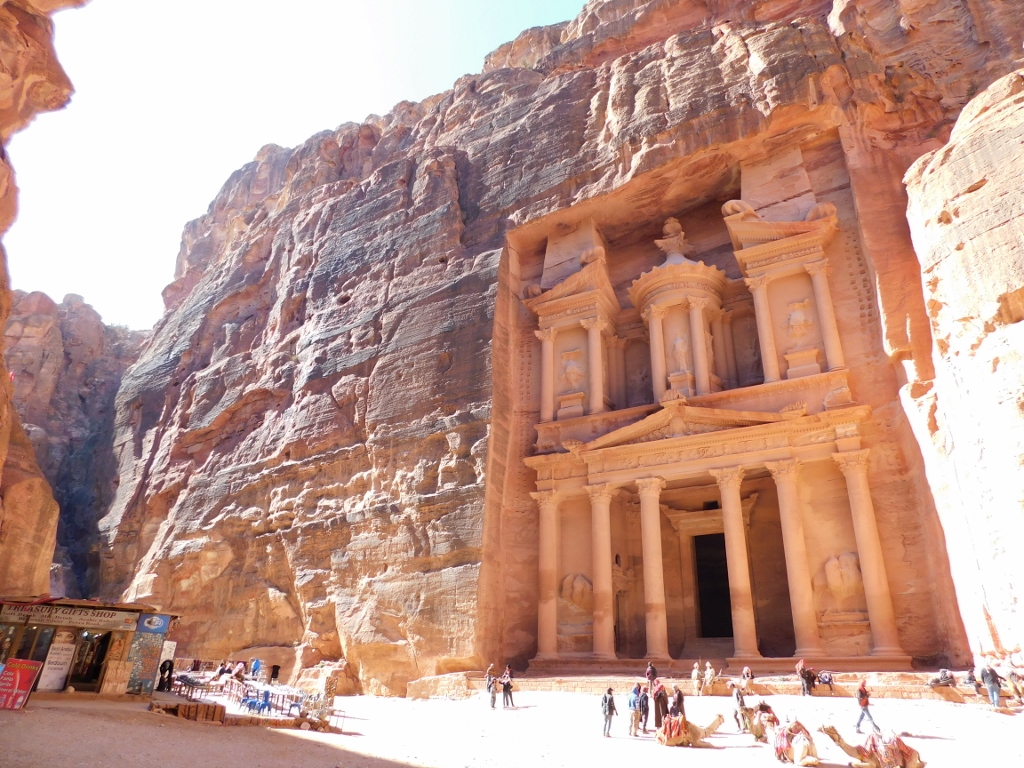 Petra, Wadi al-Jarra with al-Khazneh
Petra, Wadi al-Jarra with al-Khazneh
Although there were people in front of the Treasury in Wadi al-Jarra, I must say that most of them were local Bedouins who were trying to get some work, either by taking tourists to a nearby viewpoint, or showing them around the site, or offering to take photos of them or to ride a camel. Even though I would have felt better physically if I had walked less, I had an impression that the images of Petra would somehow just fly by me in this way, while I wanted to enjoy in them for as long as possible. That’s why I just took photos of some camels and continued on foot.
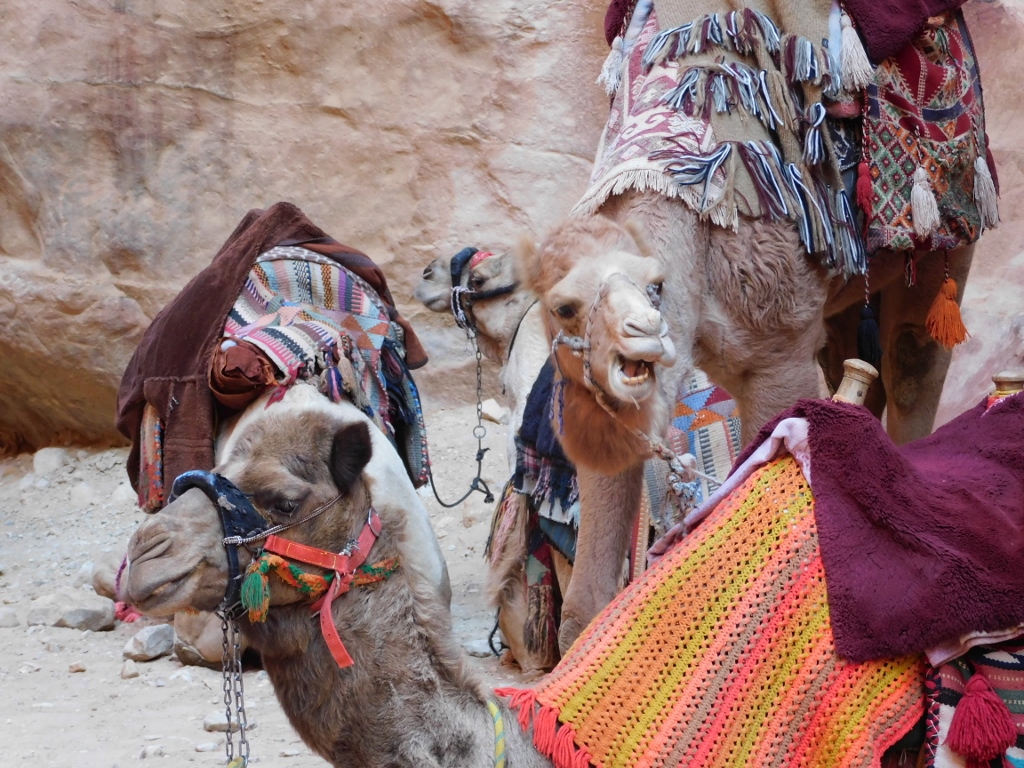 Petra, a detail
Petra, a detail
Thus I walked again along the Outer Siq and the Street of Facades, which led me to the Theatre Necropolis, as well as the Theatre itself. I have already written about all of this, so I will not repeat it.
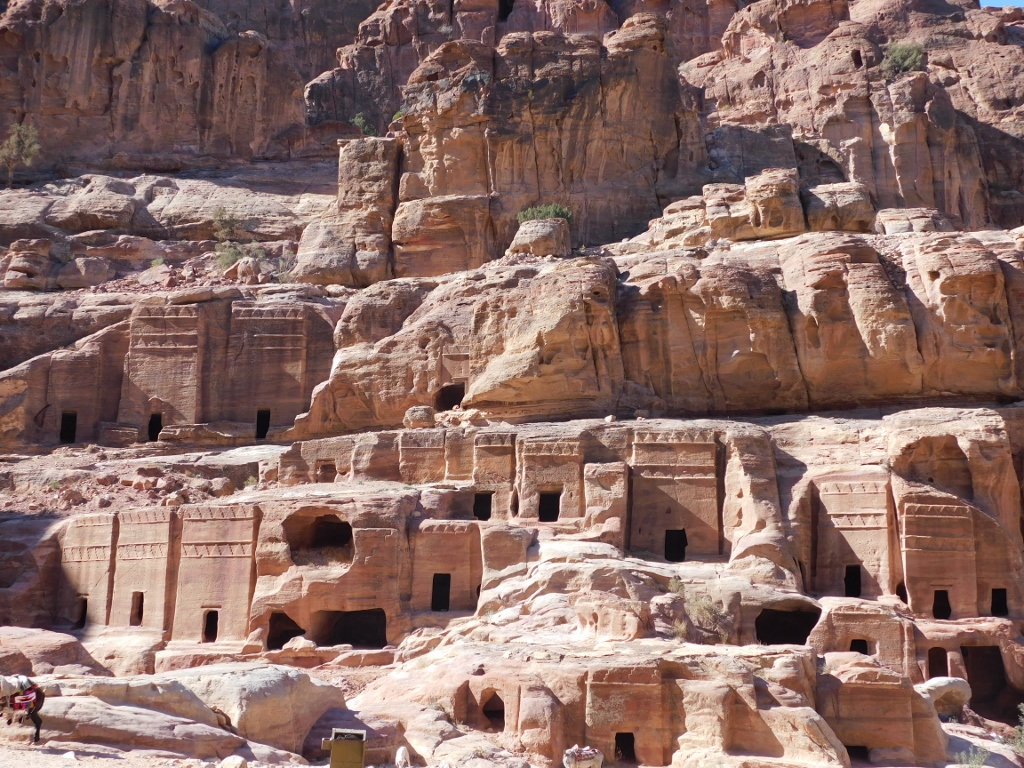 Petra, Theatre Necropolis, a detail
Petra, Theatre Necropolis, a detail
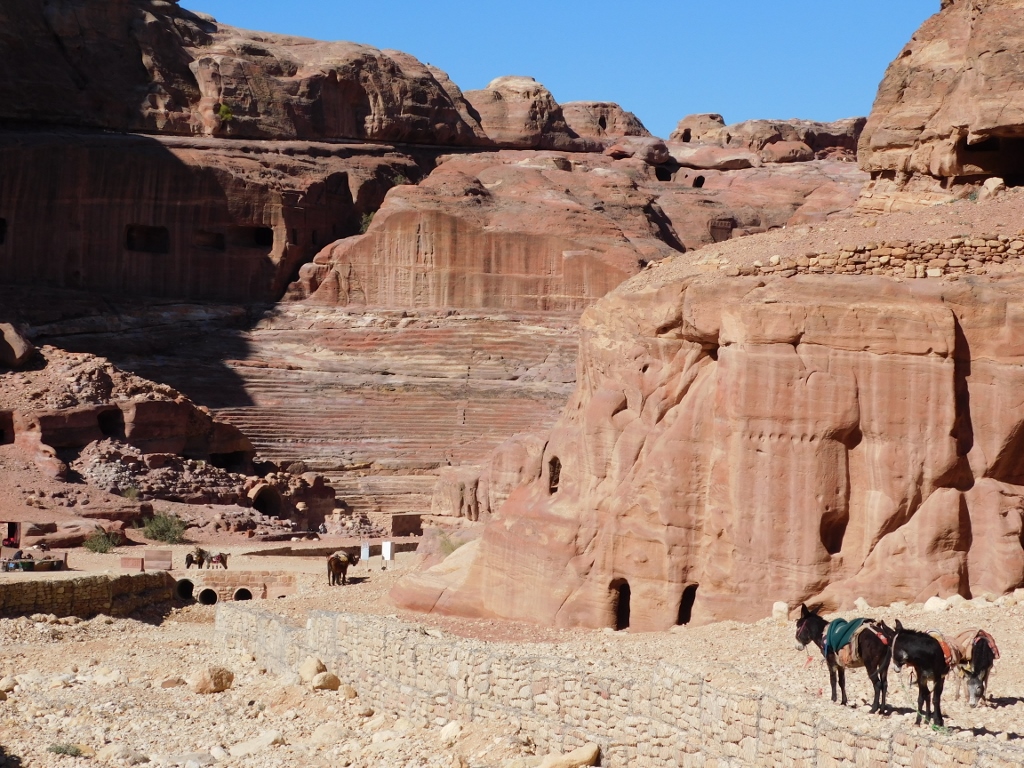 Petra, Theatre (to the left, a little farther away)
Petra, Theatre (to the left, a little farther away)
What I wanted to visit first on this day were the Royal Tombs. In order to do that first I had to climb an elevation that belongs to the Jabal al-Khubtha massif. From there, there was a fine view at the central part of Petra and the entire valley in which it is located. In the photo below, all the way to the left, in the shade, it is possible to see the Theatre, then in the middle is the Street of Facades which when it turns to the left (on the right-hand side of the photo) and from the Nympheum it turns into the Colonnaded Street. This is also the main route for the visitors. If one wants to follow other routes, and there are several of them, one must climb the surrounding rocky hills and mountains.
 Petra
Petra
Although Petra itself is located in a completely arid area, the visitors need not worry. In several pointa around the site it is possible to sit down and refresh.
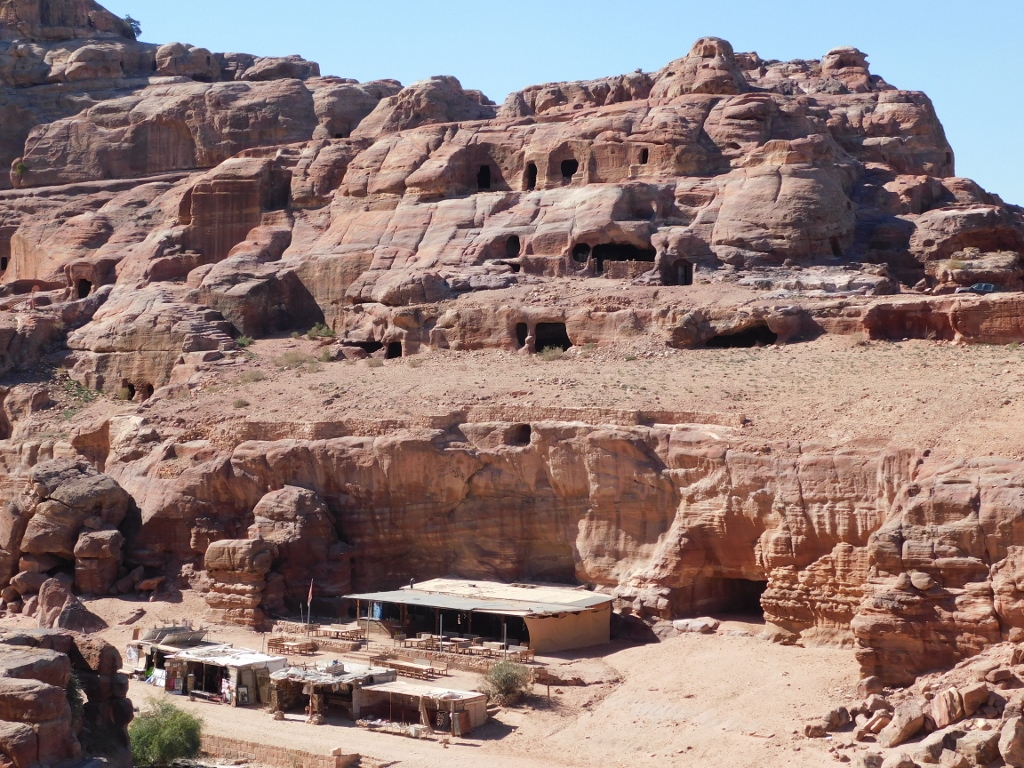 Below: stands with merchandise are in the front row, the bar/restaurant is in the back. Above: numerous caves made by the human hand
Below: stands with merchandise are in the front row, the bar/restaurant is in the back. Above: numerous caves made by the human hand
There are also toilets, so one should not worry at all. Except, probably, during summer. It must be for sure extremely hot then and this problem can particularly become exacerbated when one crosses open areas with no shade. In January, when I was here, there were no problems of the kind. As it may be seen in the photos, I had beautiful sunny weather all the time, but the photos may be misleading up to a point. First of all, a couple of days before my arrival, as well as a day or two after my departure, there was snow in Petra! Admittedly, this can certainly introduce some interesting visual effects, but I don’t know how safe it is then to climb the, perhaps, slippery rocks.
On the other hand, regardless of the sunny weather, it was quite fresh and occasionally cold. I had my two jackets on and I often had to put on my woollen cap. To my great regret, the previous afternoon I realised I had lost the cap in the meantime and this constituted a partial problem on this day. But, I solved it by wrapping a large cotton scarf around my head.
Before I started with my visits to the Royal Tombs, first I walked a little in their surroundings where it is possible to see some other, less important structures made by the Nabataeans. What absolutely fascinated me most here, in addition to this skill and the need of the creators, were – the colours of the sandstone. I have already mentioned before that Petra is often called the Rose Red City. And this is no exaggeration at all.
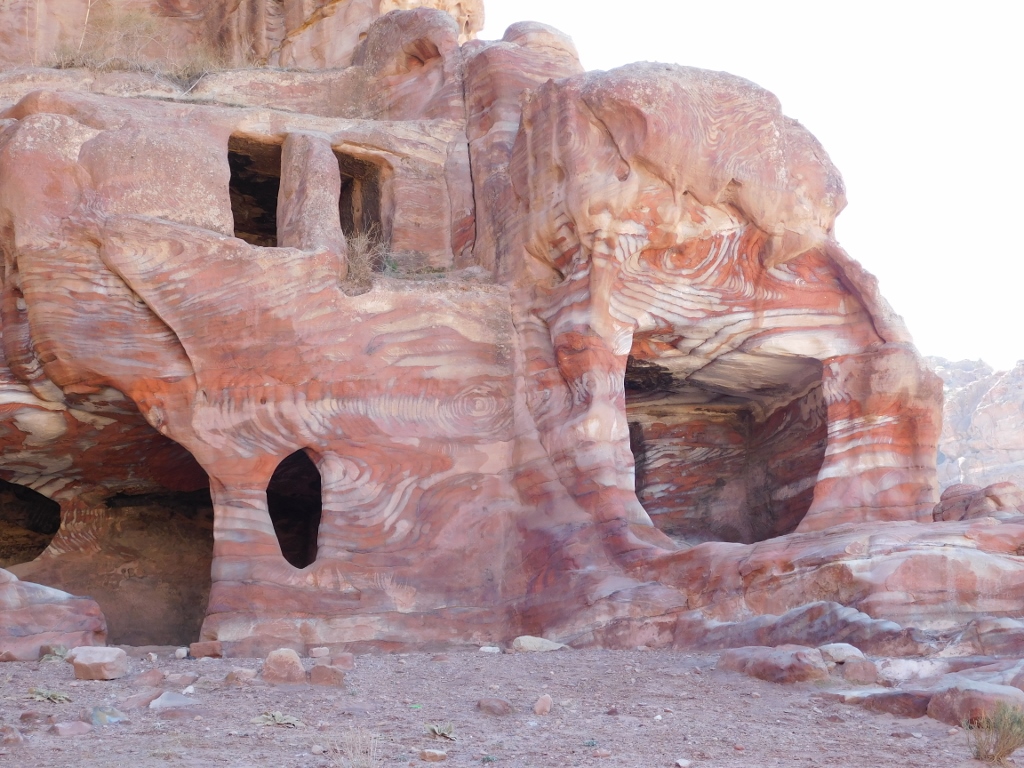 Petra, details of the rose red rocks
Petra, details of the rose red rocks
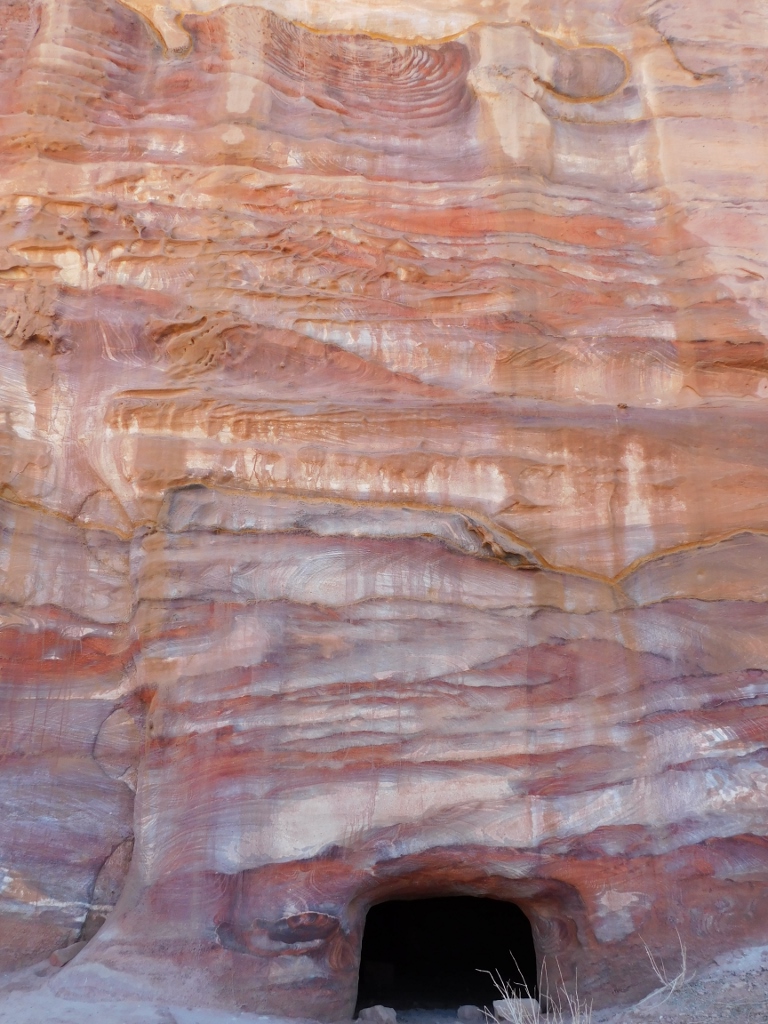 Petra, details of the rose red rocks
Petra, details of the rose red rocks
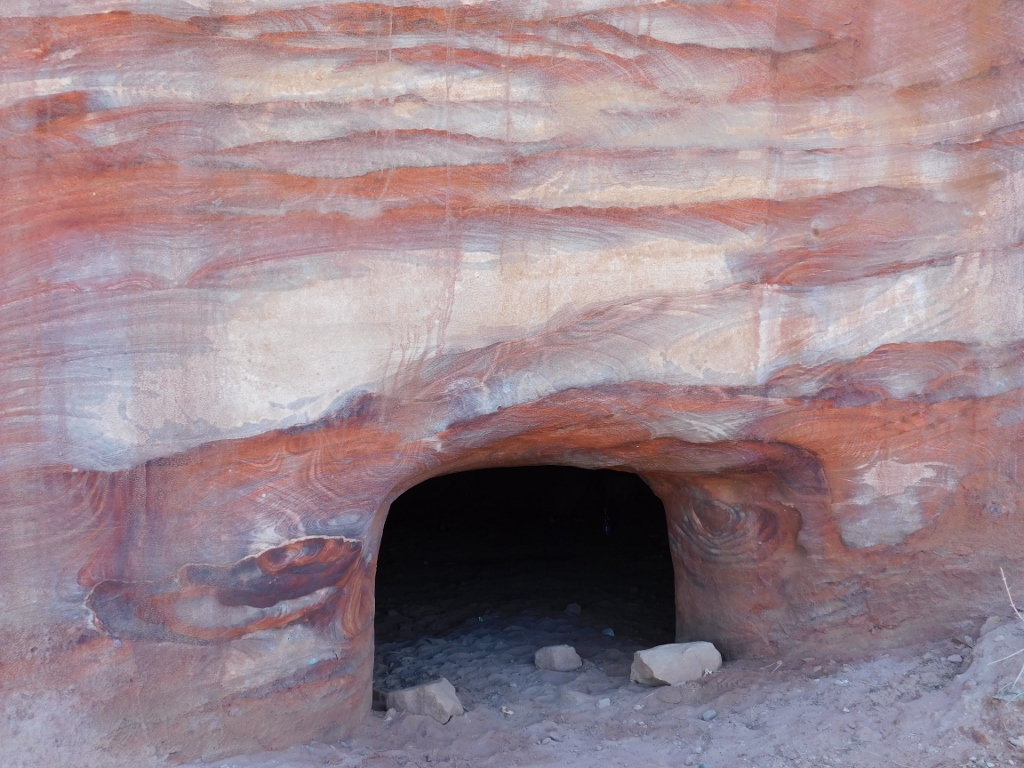 I got close to here in order to see better the incredible beauty of the rocks
I got close to here in order to see better the incredible beauty of the rocks
Still, the main reason for getting to this part of the site was the visit to the Royal Tombs, so now I headed in their direction. The first one is the Urn Tomb. This is the tomb the facade of which is seen in the cliff above the numerous arches.
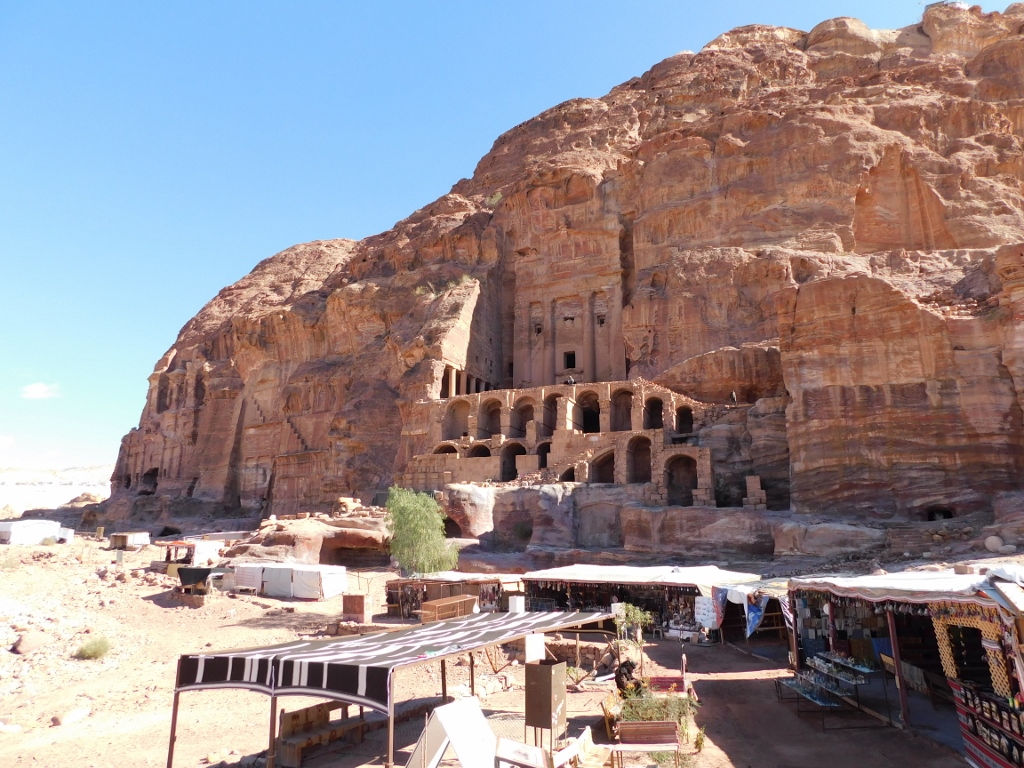 Petra, Urn Tomb
Petra, Urn Tomb